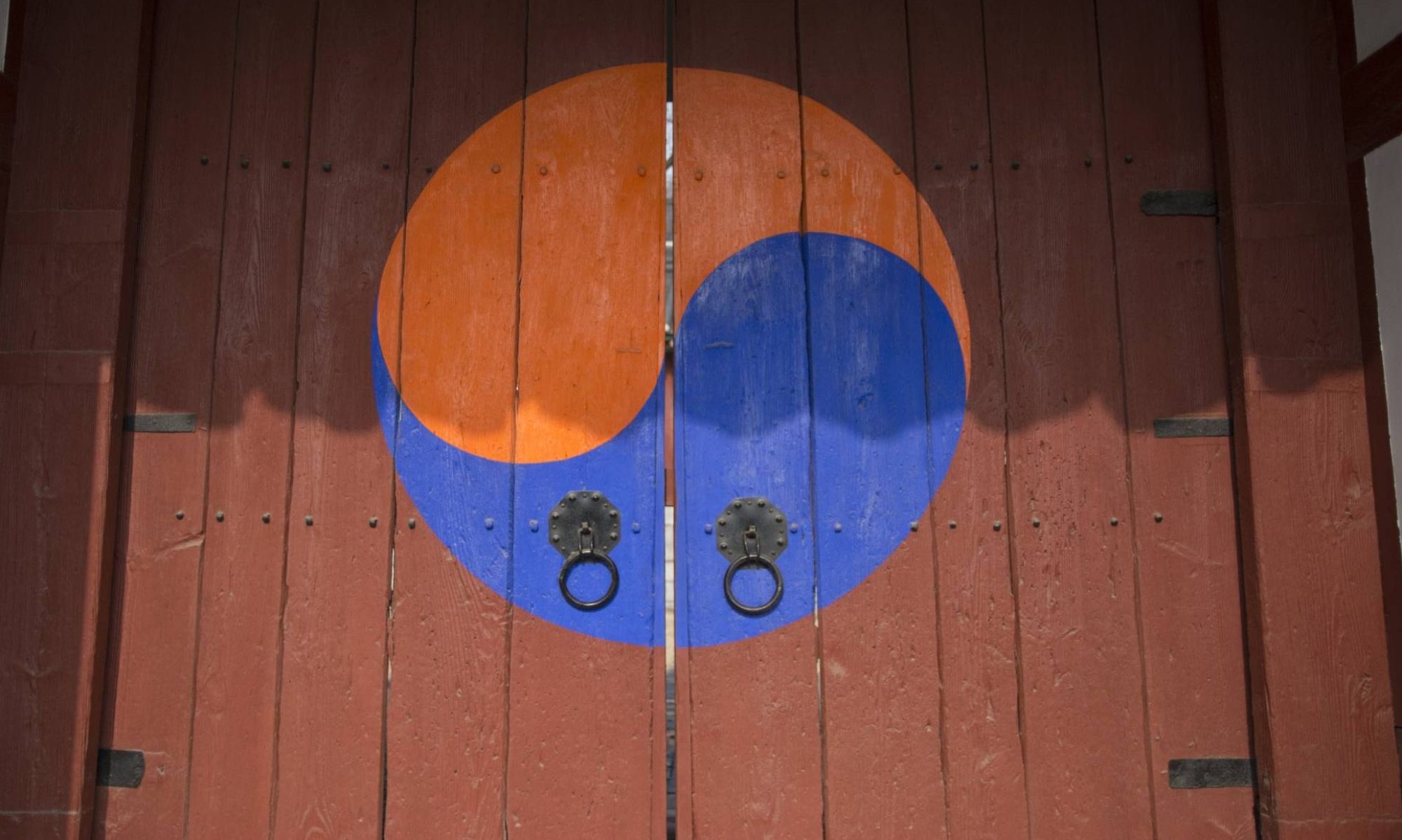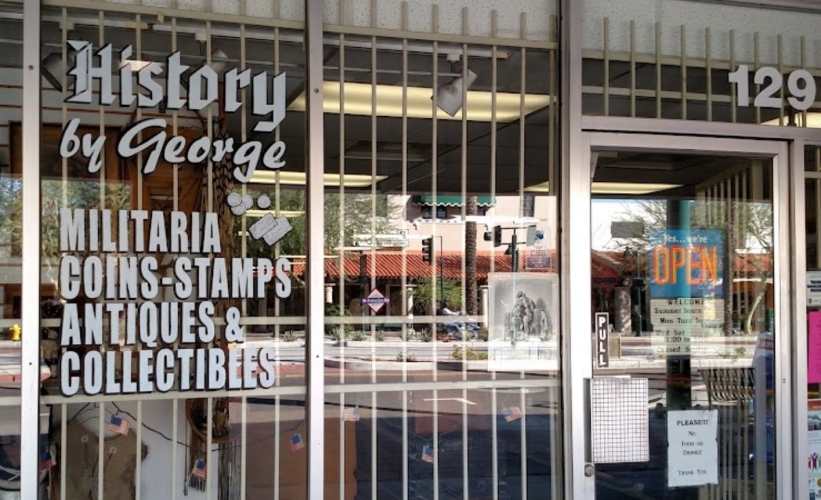
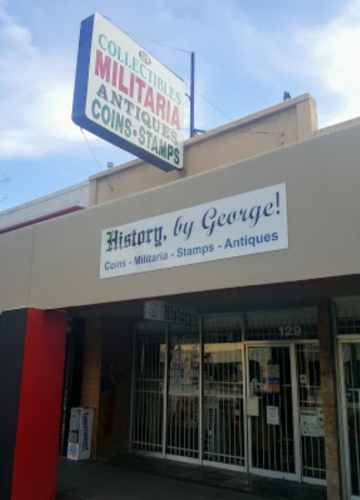
Mr. Notarpole is a well-known, knowledgeable and respected collector and dealer. His interests include militaria, historical antiques, edged weapons, medals, U.S. and foreign coins & currency, tokens, political, stamps, art and collectables, military books and much more. George and his wife, Ko, maintain a website at www.historybygeorge.com. A quick perusal of the website will reveal a broad range of interests. The items belonging to Mr. Notarpole, which are pictured on this website, are from his personal Korean collection and are not for sale (believe me, I tried). He asks that he not be bothered about his personal collection.
Their store is located at 129 W. Main St., Mesa, Arizona 85201. If you wish to visit the store, I suggest that you call them ahead of time, as they take a number of buying/selling trips every year. Most, but not all, of these trips are posted on their web-site. Their contact phone numbers are 480-898-3878 (Store) and 480-309-1217 (Cell) and he is generally available from 11:00 am to 5:00 pm, Tuesday through Saturday, Mountain Standard Time (MST). Keep in mind, Arizona does not observe Daylight Savings Time. You will find additional pictures of their shop here.
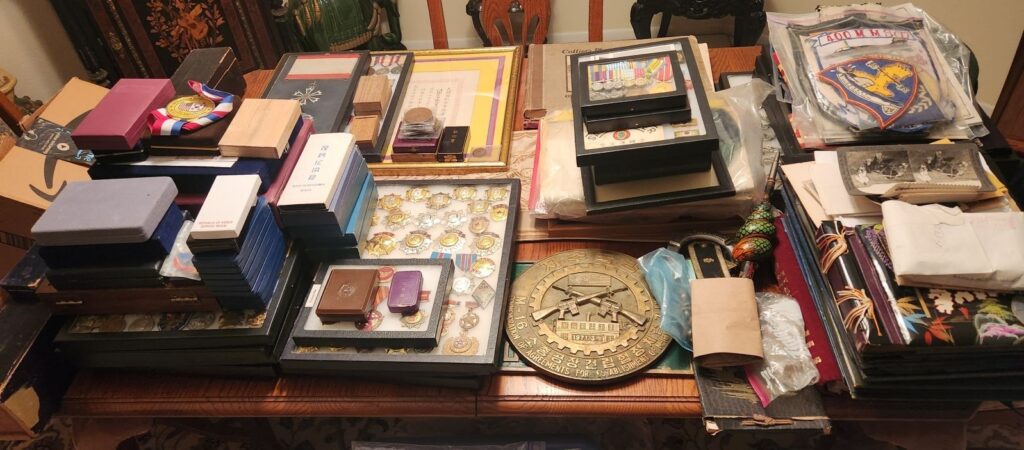
Korean Empire, Orders and Commemorative Medals
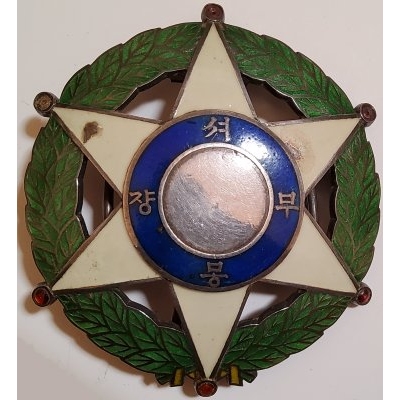
Although damaged, this is the only known breast star from the Order of the Auspicious Phoenix 서봉장.
Notice that 셔봉부쟝 is written around the center. 셔봉 is the original name for the order. The last two words 부쟝 is the original way of saying Breast Star. Also notice that the phrase is not written in traditional Chinese but in Hanʼgŭl (한글). At that time, the literati referred to Hanʼgŭl derisively as ‘amkeul‘ (암클) meaning “Women’s Script”.
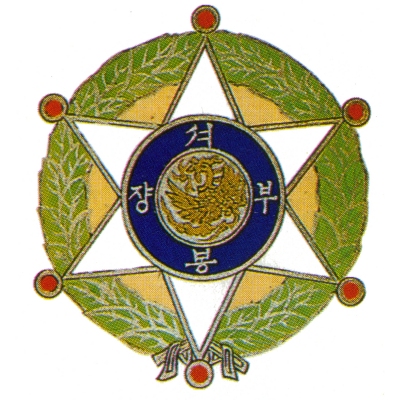
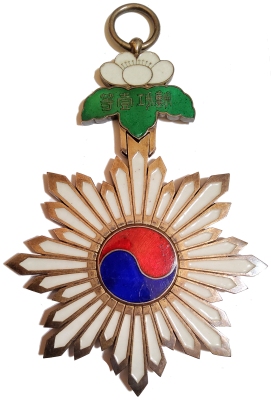
태극장
1st Class 一等
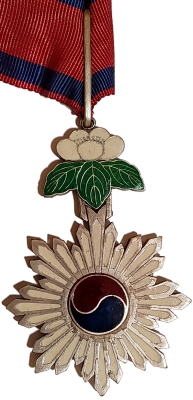
태극장
3rd Class 三等
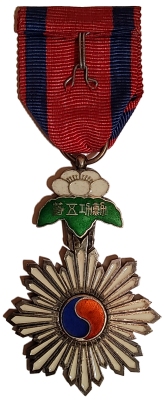
태극장
5th Class 五等
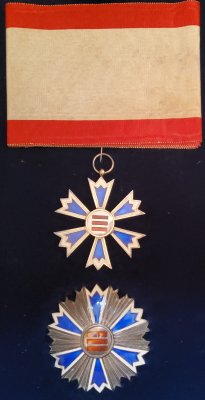
팔괘장
1st class 一等
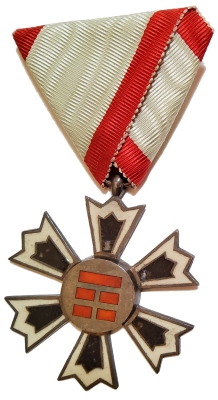
팔괘장
7th class 七等
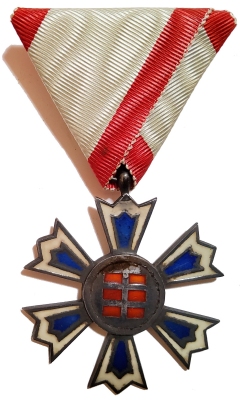
팔괘장
8th class 八等
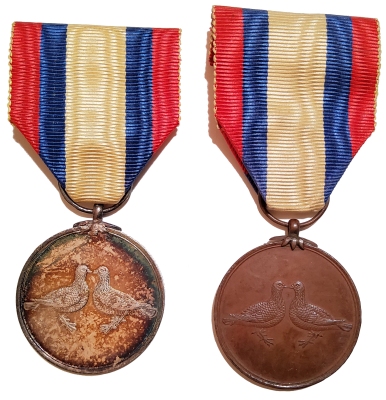
皇太子 嘉禮 記念章 (황태자 가례 기념장).
One in Silver and one in bronze.
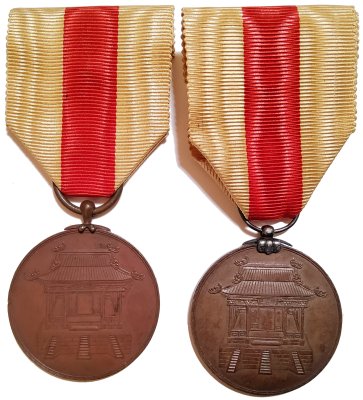
고종황제 망육순과 등극 40주년 기념장
Notice the two different suspension devices
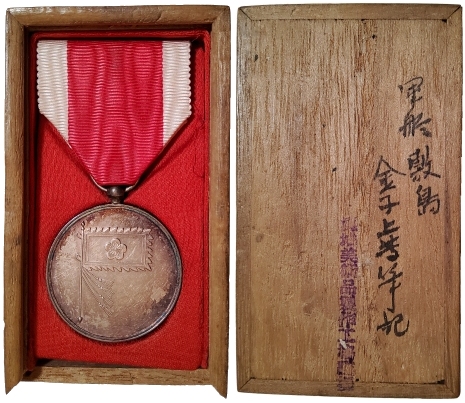
純宗 南西巡幸 記念章 (순종 남서순행 기념장) With a picture of the underside of the box, giving the original information on the recipient.
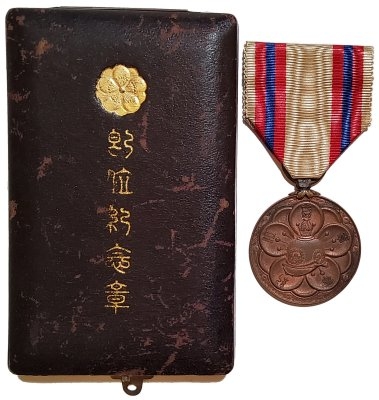
순종황제 즉위 기념장
Award document and translation to the right.
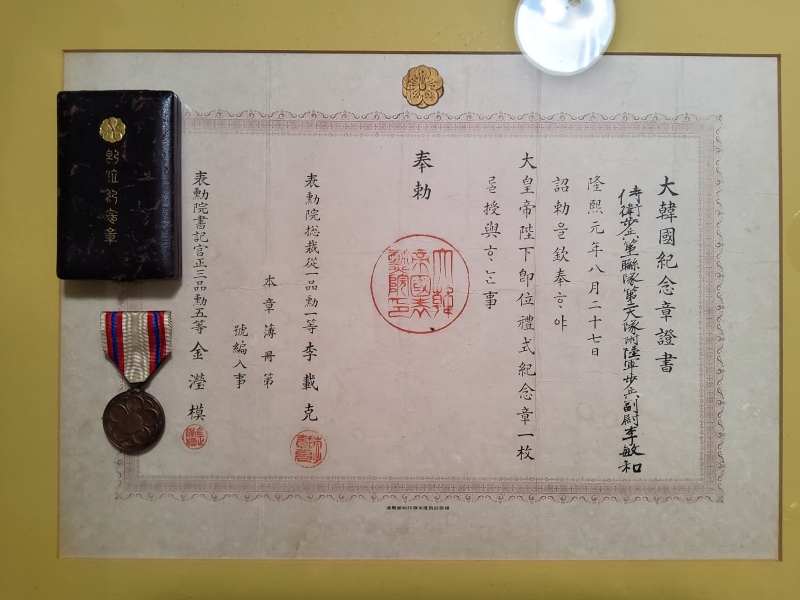
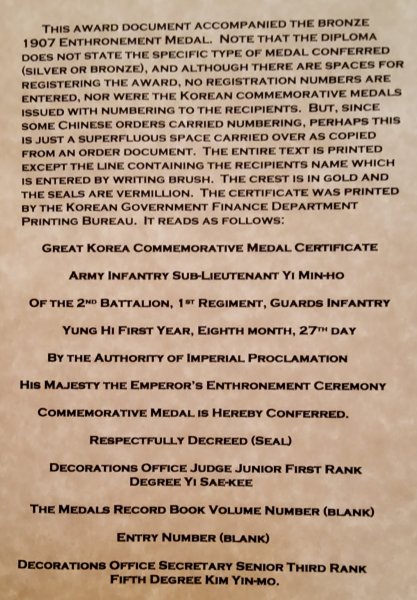
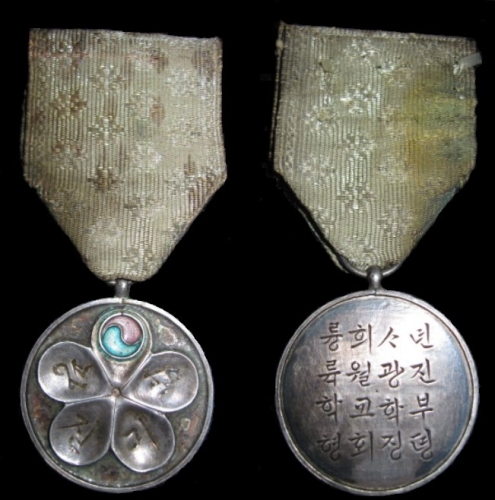
For more information on this medal see my webpage “Other Medals of the Korean Empire“
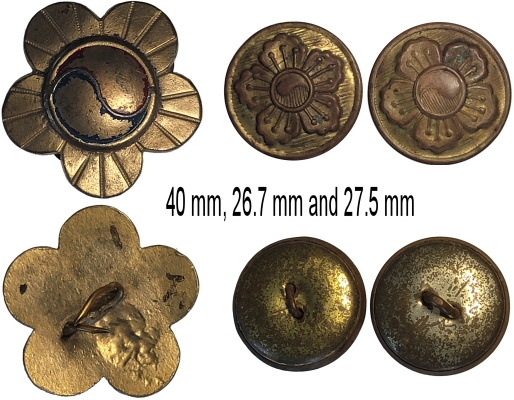
The large one to the left is from the uniform of an official of the Korean Empire.
The difference lies in the five lobes around the Taeguk. Smooth lobes are Korean Empire while those lobes resembling Mugunghwa flower petals are South Korean.
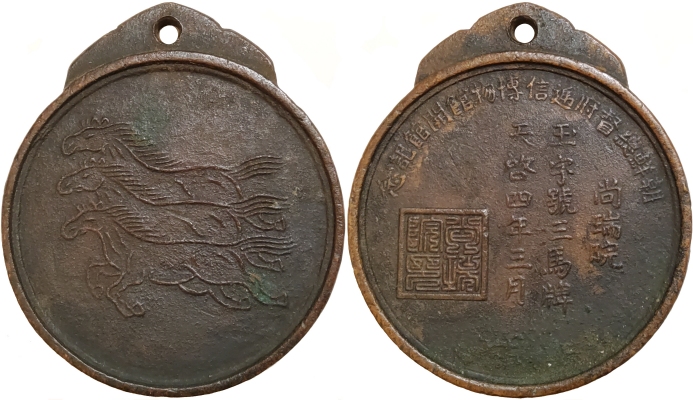
Opening of the Governor-General’s Office of Korea Post and Communications Museum
朝鮮總督府逓信博物館開館記念 .
The three vertical lines and the seal are a reproduction of a MaP’ae (Horse Warrant):
1. 尚瑞院 – Sangseowon was an institution under the Ministry of Personnel during the Choson Dynasty, in charge of the seals, sacred objects and treasures of the king, etc/.
2. 玉字號三馬牌 – Three Jade Horses Medal (lit. 玉字號 = Jade Mark),
3. 天啓四年三月 – March 1624 The Chinese Emperor Cheongye (Ming dynasty 天啓 천계 1623–1627 CE) used Tianqi as his adopted era name.
And finally, the Official Government Mint Seal with the characters 尙瑞院印 rendered in Seal Script, within a boxed frame.
For more information, see “Cast Coinage of Korea” by Edgar J. Mandel, page 129.
Translation courtesy of Nick at Medals of Asia
Horse Warrants MaP’ae 마패 (馬牌) For more on these, see my Horse Warrants Webpage
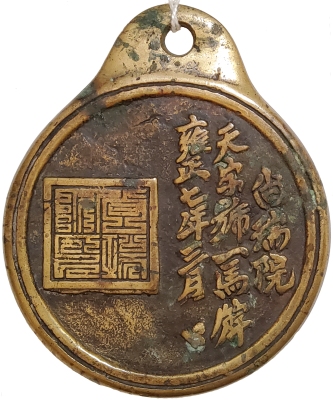
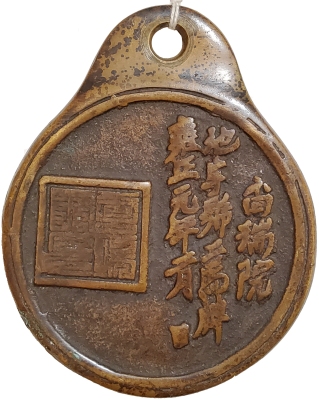
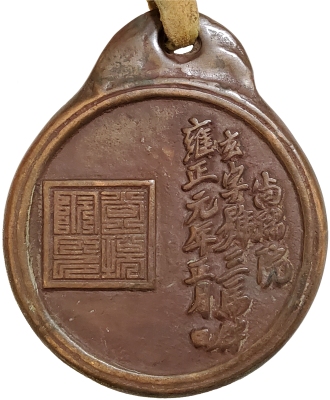
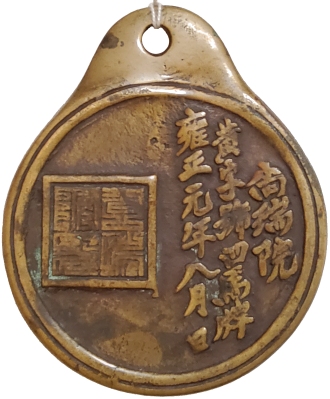
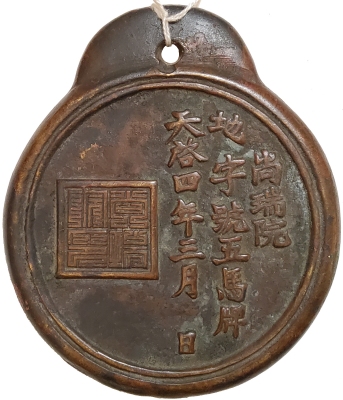
Japanese Colonial Period
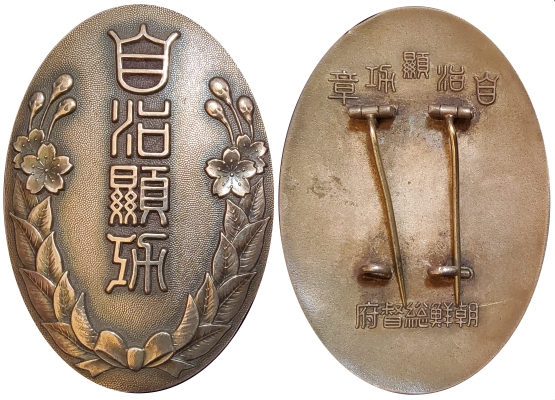
Reverse inscription: Top line自治顯功章 Self-government Distinguished Merit Badge (자치현공장). Bottom line: 朝鮮総督府 Korean Governor-General’s Office (조선총독부).
Interesting that it has Cherry Blossoms and not the usual Korean Governor General’s seal. Probably not meant for Koreans.
Translation thanks to Nick at Medals of Asia.
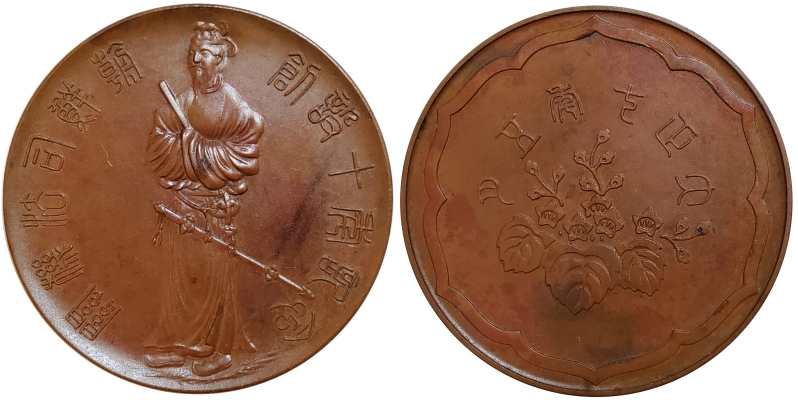
Reverse inscription: Taisho 7th year 5th month 大正七年五月 (May, 1918).
Obverse inscription: Chosŏn administration of justice 朝鮮司法機關, 10th Anniversary of Founding 創報十年紀念.
The figure in the center is Prince Shotoku Taishi 聖徳太子 (574-622). He was a semi-legendary regent and a politician during the Asuka period (538 to 710) of Japanese history. The prince is renowned for modernizing the government administration and for promoting Buddhism in Japan.
The 10th anniversary of Founding refers to the Japan–Korea Treaty of 1907 and the subsequent realignment of the Government. Under the treaty, the Korean government could only act under the guidance of the Japanese resident general. In effect the administration of Korea’s internal affairs was turned over to Japan.
Bronze 55 mm
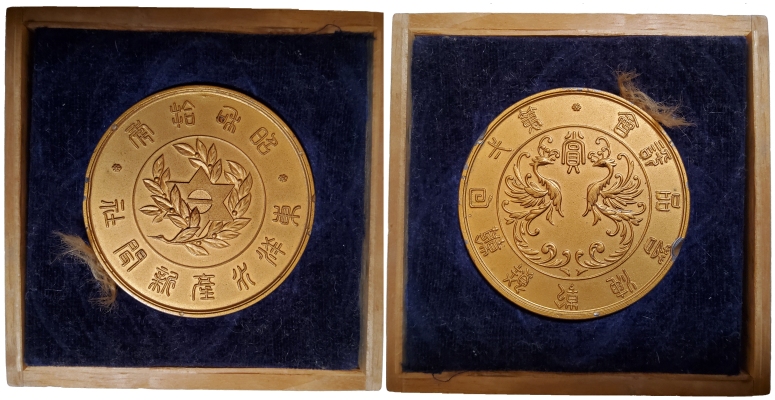

Obverse: a draped, seated semi-nude man holding a shield and, in the distance, can be seen Namdaemun (the Great South Gate in Seoul) and a Shinto torii gate.
Reverse: 13th Annual第十三囬 Chosen Shinto Shrine Athletic Meet 朝鮮神宮体定大會 and across the center 2597 弍五九七 (1937)
Bronze 33 mm

(Side note: At the end of World War II, several KLA soldiers entering Korea, were arrested as spies because they were wearing American Uniforms. These individuals were trained by the American Office of Strategic Services (OSS Detachment 202) and were supposed to be in American uniforms.1 Not wanting a repeat incident, the United States Army Military Government in Korea (USAMGIK) told the KLA that they could only return to Korea in civilian clothes. Most of the KLA insignia was lost at that time. These KLA Cap Badges rarely come up for sale, but they are the most commonly available item of the KLA. This is a collecting area full of landmines, since there are good quality reproductions available.)
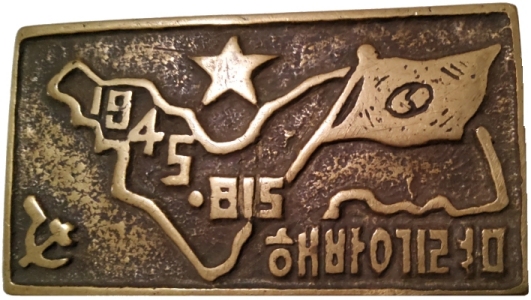
1945.815 해방기렴
“Aug.15, 1945 Celebration of liberation”
This belt buckle is a good example of Korean Unassembled Writing. You will notice that 해방기렴 is written as ㅎㅐㅂㅏㅇㄱ ㅣㄹㅕㅁ.
There was a minor and unsuccessful movement to abolish Korean syllabic blocks and write the letters individually and in a row (풀어쓰기 ‘Unassembled Writing’). Had it been successful, Korean would be written the same way that Latin alphabets are written. However the standard convention of assembled writing (모아쓰기), has remained in common use with many Koreans finding the Unassembled Writing to be confusing. As an example, the city of Inchon Korea has used the unassembled writing and you will occasionally find Inchon 인천 written as “oㅣㄴㅊㅓㄴ”. Another example is the badge of the Korea Veterans Association (대한민국 재향군인회) which displays the association name as ㄷㅐㅎㅏㄴㅁㅣㄴㄱㅜㄱㅈㅐㅎㅑㅇㄱㅜㄱㅇㅣㄴㅎㅗㅣ.
Good Luck Flags (寄せ書き日の丸, yosegaki hinomaru)
A recent acquisition (2025). This Japanese flag references Gunsan, Korea 群山 (군산, Kunsan, Gunzan).2 The Japanese refer to their flag as Hinomaru 日の丸, “sun circle” or Nisshōki 日章旗, “flag of the sun”. During WWII, American servicemen referred to them as “Meatball” flags.
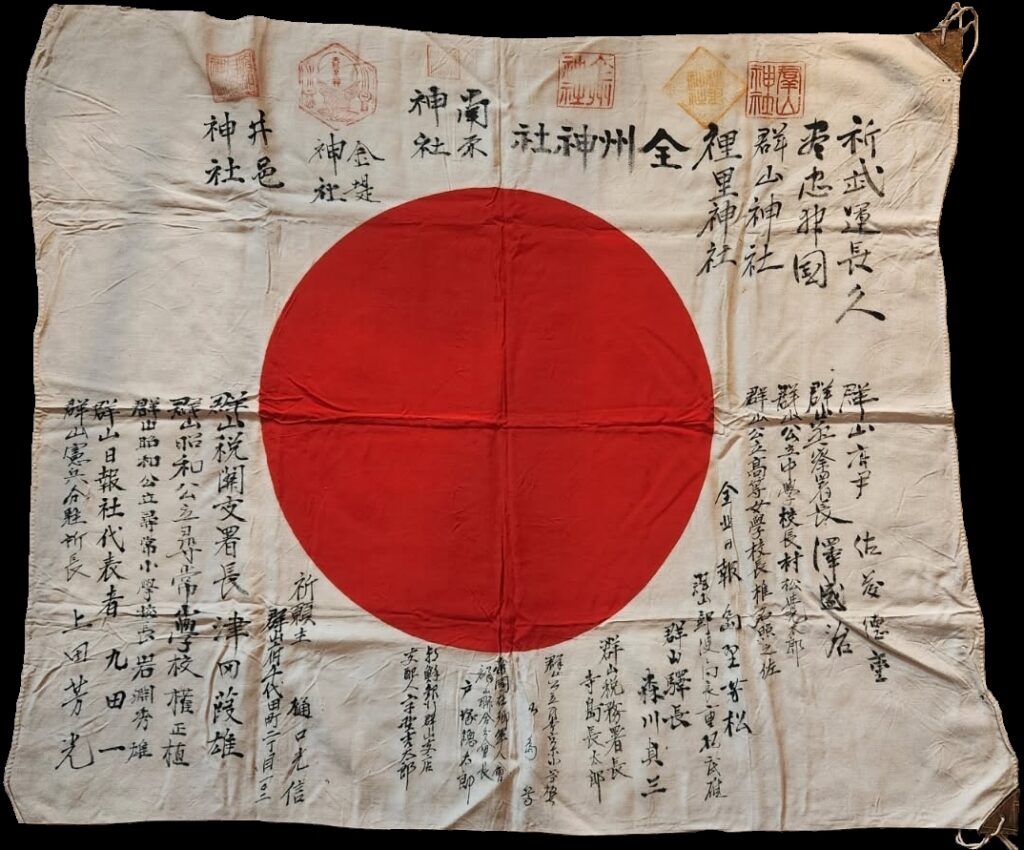
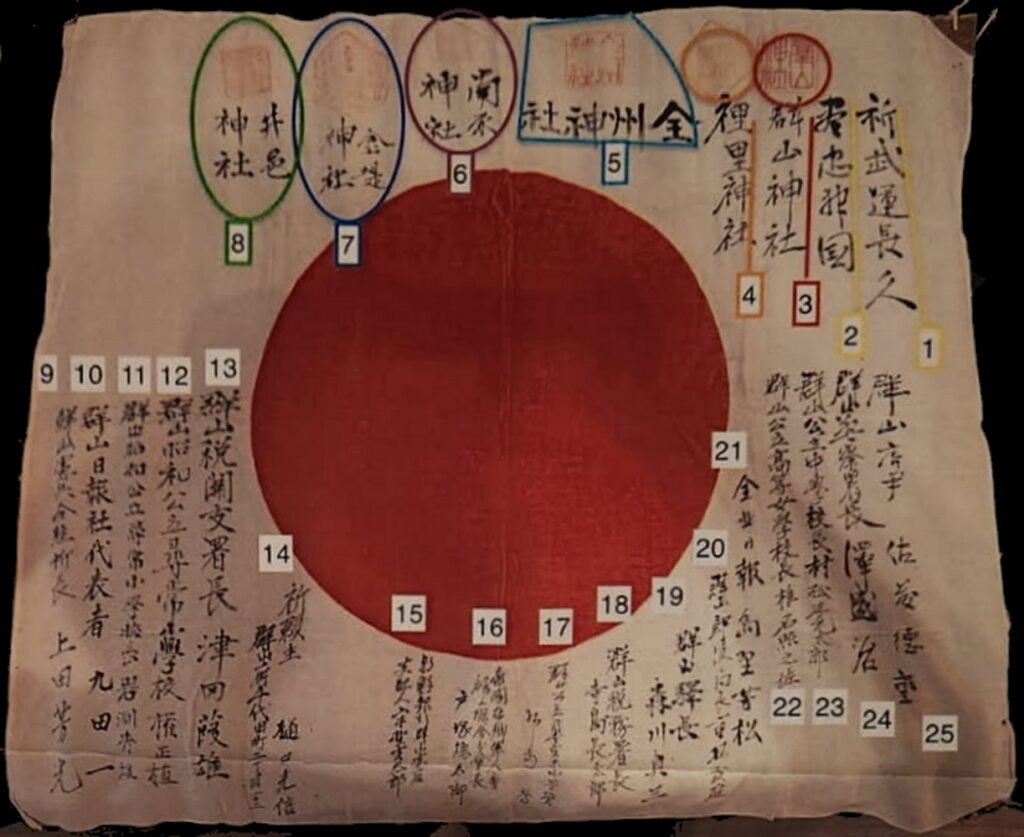
- Prayer for eternal good fortune in war
- Sincere loyalty in service to the nation
- Gunsan Jinja
- Risato Jinja
- Senshu Jinja
- Minamihara Jinja
- Kogane Jinja
- Sieyu Jinja
- Commander of the Gunsan Branch of the Kempeitai
- Editor of the Nippo Newspaper of Gunsan
- Gunsan Showa Public Elementary School Principal (for Japanese students)
- Gunsan Showa Public Elementary School Vice-principal
- Gunsan Tax Office Section Chief
- Head Priest, Gunsan Chiyoda Ward
- Branch store of the (illegible) shop
- Head of the Japanese Imperial Retired Military Association
- Gunsan (illegible) Elementary School Principal
- Gunsan Import Duty Tax Official Chief
- Gunsan Train Station Master
- Gunsan Postmaster
- Zenshu Nippo Newspaper Editor
- Gunsan Girls Public High School Principal
- Gunsan Public Middle School Principal
- Gunsan Police Chief
- Gunsan (illegible)
“Jinja 神社” is a locally or regionally sponsored Shinto Shrine, while a “Jinju 神宮” is a nationally sponsored Shinto Shrine or a Shrine dedicated to the royal family or royal ancestors.
The Japanese national flag is officially called the Nisshōki (日章旗, ‘flag of the sun’ or ‘circular sun’) but is more commonly known in Japan as the Hinomaru (日の丸, ‘ball of the sun’). Yosegaki translates as “collection of writing”. So Good Luck Flags, ‘Yosegaki Hinomaru’ can be interpreted as a “collection of writing around the red sun”. These were traditional gifts for Japanese servicemen deployed during Japan’s military campaigns. They were presented before the man’s induction into the Japanese armed forces or before his deployment. Friends and family, would write short messages wishing the soldier victory, safety and good luck.3 Normally, the flag is signed only around the red center, but there are examples with characters written on top of the red center. Good luck flags predating the Manchurian Incident (1931) are considered rare. The vast majority of these flags date from the Second Sino-Japanese War (1937–1945). These flags were often kept as souvenirs by American servicemen. Millions of these flags were produced and they were plentiful on the battlefield, but were generally unobtainable by American servicemen who were not in combat. It is known that enterprising servicemen were involved in making reproductions. For more on these reproductions/fakes, see the Medals of Asia webpage. One, often encountered, dead giveaway to reproductions is the inability of American servicemen to properly write Chinese and Japanese characters. Some modern reproductions have simplified Chinese characters, which were not used until 1946, after the end of WWII. The Obon Society is a Japanese non-profit organization with a mission to return Yosegaki Hinomaru and other non-biological artifacts to their families in Japan. Today, Yosegaki Hinomaru are used for occasions such as charity and sporting events.
The following pictures are of the Shinto Shrines listed on the Good Luck Flag above. The Gunsan Jinja was located in Gunsan (Kunsan), Korea and the Zenshū Jinja was located in Jeonju, Korea. The original locations of the other shrines are unknown. The vast majority of these shrines were destroyed by the Koreans within weeks of liberation at the end of WWII.

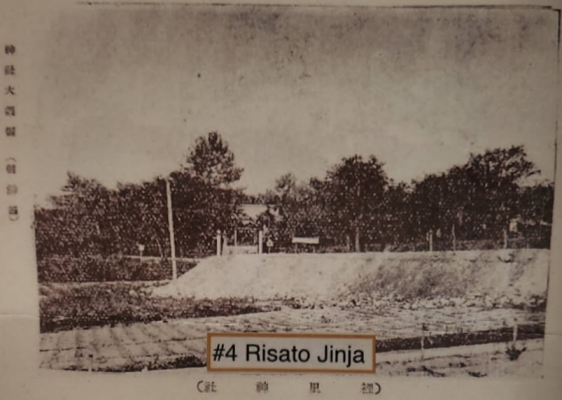

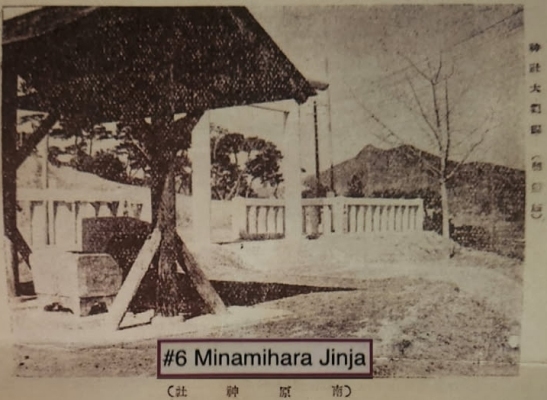

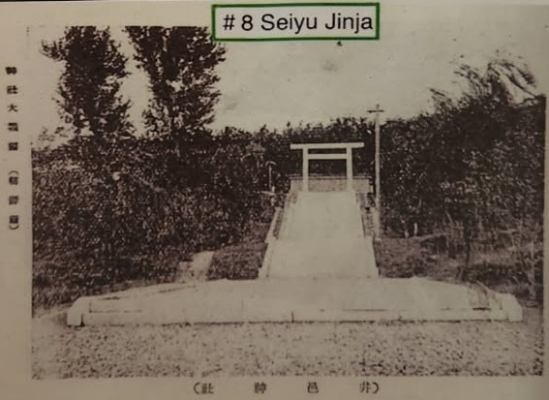
Koreans in the United States call for Independence 1919
The March 1st 1919 demonstrations in Korea led to a flurry of activity here in the United States. Here are just three Korean-American artifacts from 1919.
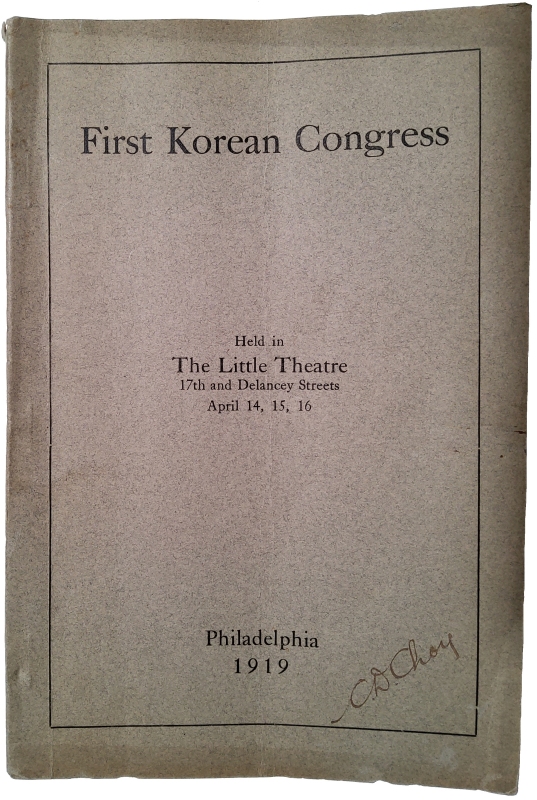
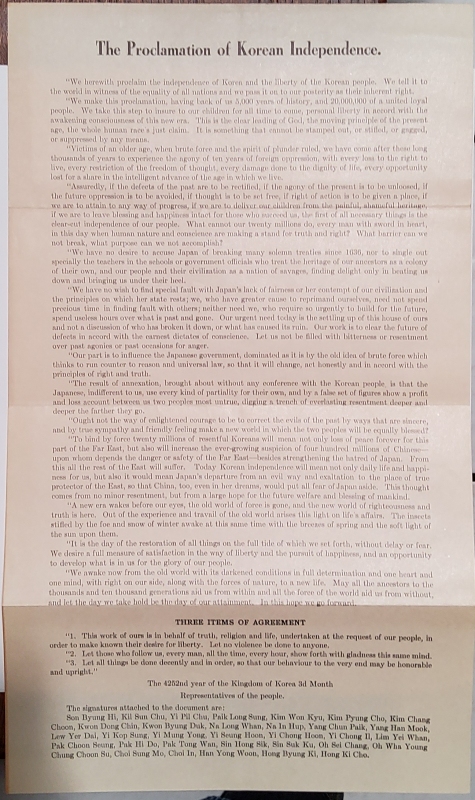
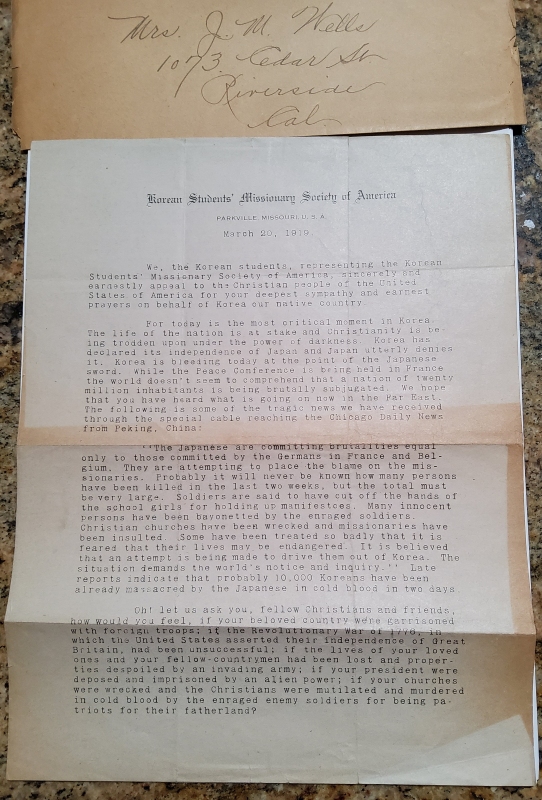
Swords
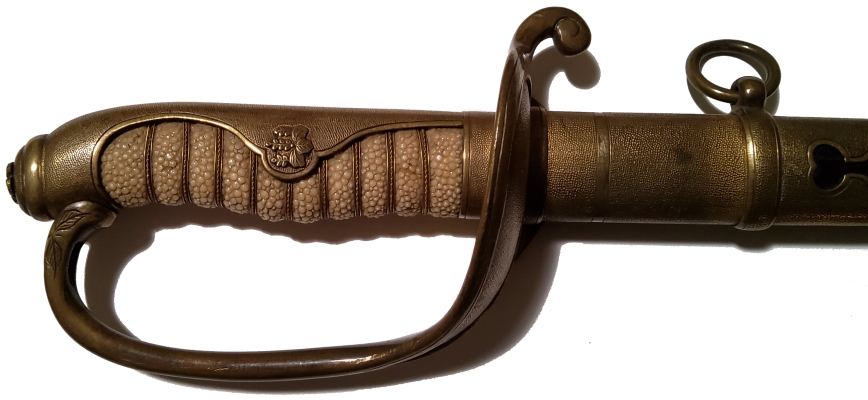
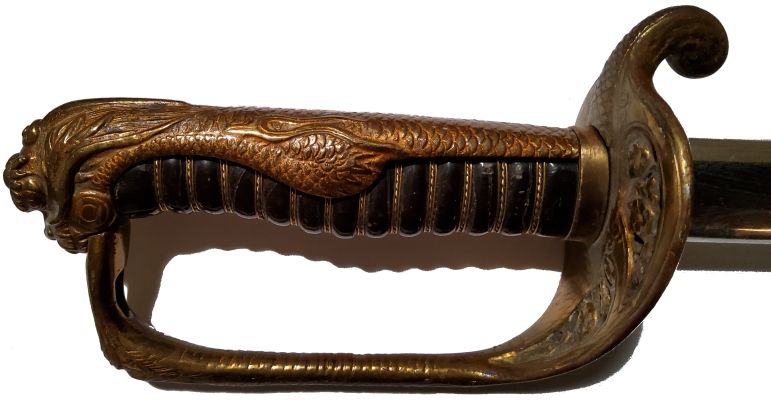
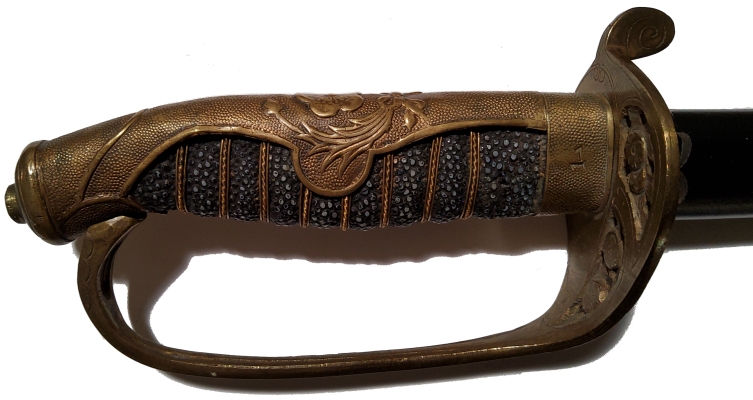
A very ornate sword from the Korean Empire

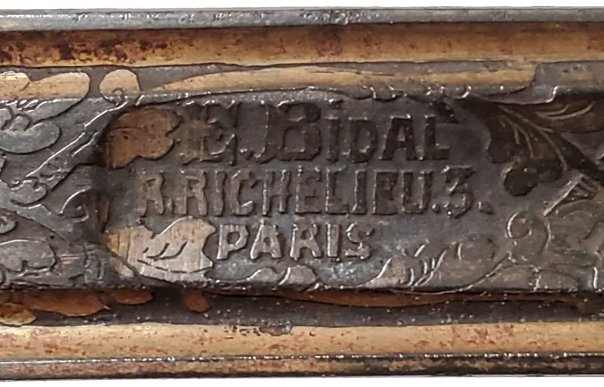
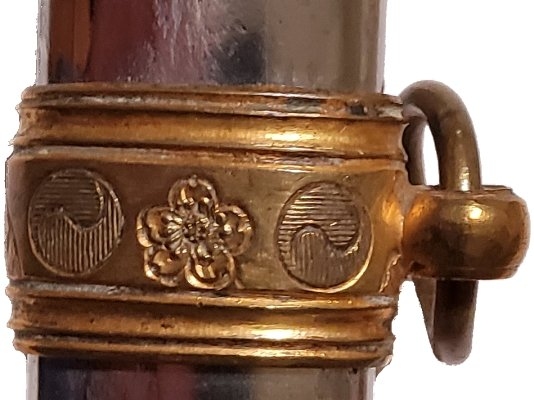
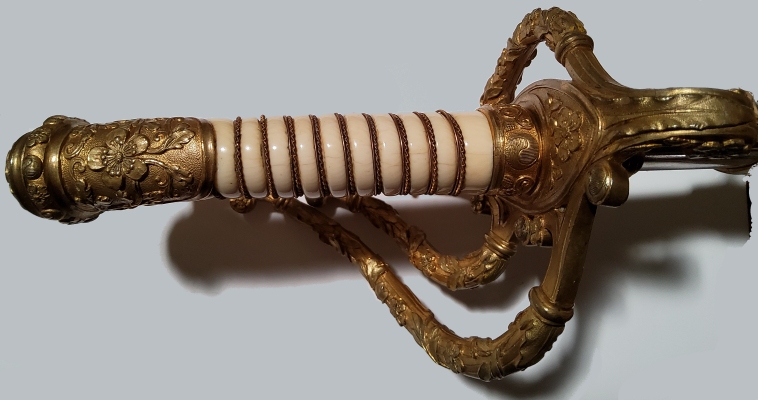
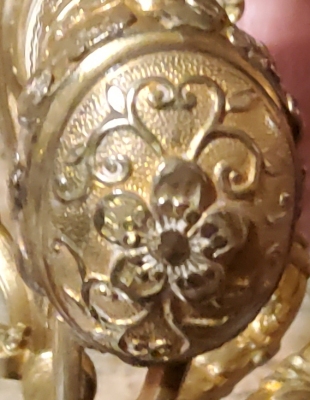
Post World War II
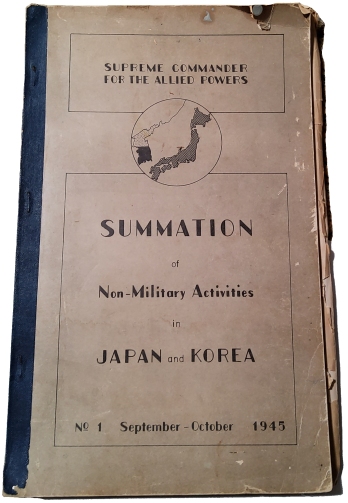
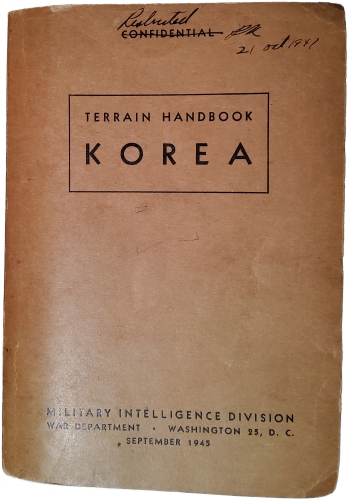
Much of this volume was taken from captured Japanese maps that were created for the exploitation of Korea.
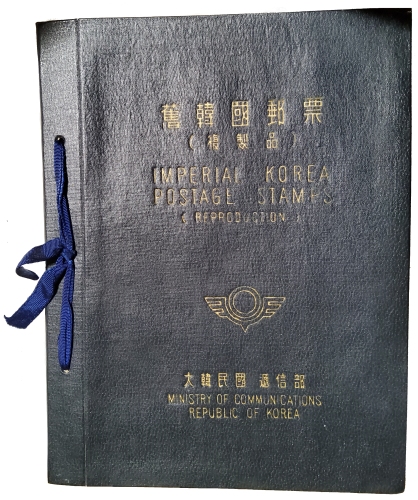
Published by the Ministry of Communications, Republic of Korea
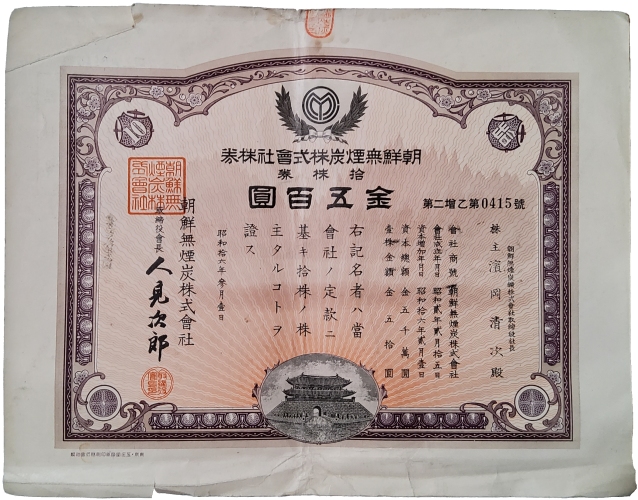
Orders and Medals and Insignia of the Republic of Korea
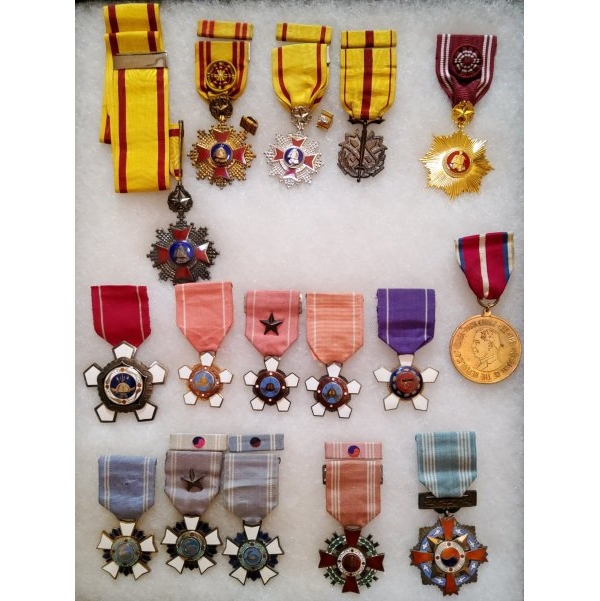
Order of Military Merit, 1967 Series, Chungmu (3rd Class)
Order of Military Merit, 1967 Series, Hwarang (4th Class)
Order of Military Merit, 1967 Series, Inhun (5th Class)
Military Merit Medal, 1967 Series
Order of Military Merit, 1973 Series, Hwarang (4th Class)
Order of Military Merit, May 1951 Series, 4th Class
Order of Military Merit, August 1951 Series, Hwarang (4th Class)
Order of Military Merit, August 1951 Series, Hwarang with star (4th Class)
Order of Military Merit, August 1951 Series, Hwarang (4th Class)
Order of Military Merit, 1963 Series, Inhun (5th Class)
President Park Chung-hee Medal
Order of Military Merit, August 1951 Series, Chungmu (3rd Class)
Order of Military Merit, August 1951 Series, Chungmu with star (3rd Class)
Order of Military Merit, August 1951 Series, Chungmu (3rd Class)
Order of Military Merit, August 1951 Series, Ulchi (2nd Class)
Order of Military Merit, August 1951 Series, Taeguk (1st Class)
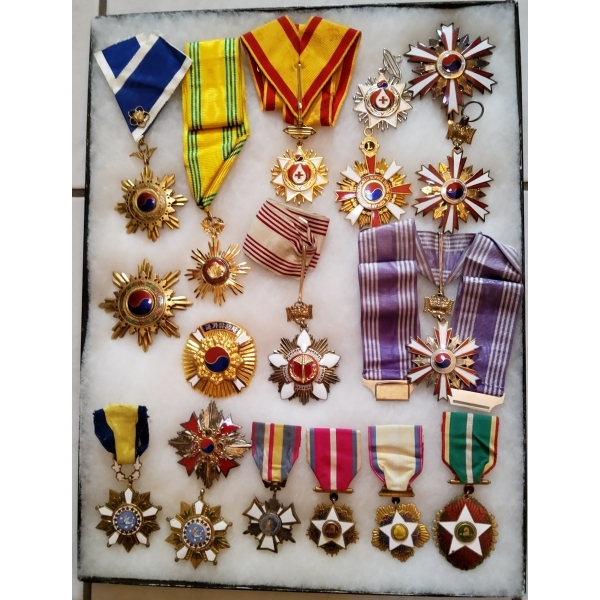
Order of National Foundation, 1963 Series, Bokjang (2nd Class)
Order of Civil Merit, 1973 Series, Dongbaeg (3rd Class)
Red Cross Blood Donation Medal, Gold (50 Pints)
Red Cross Blood Donation Medal, Silver (30 Pints) w/o ribbon
Just below the silver medal is a Lions Club Medal
Order of National Security Merit, 1973 Series, (1st or 2nd Class)
(To the right and just below the National Foundation Breast star)
Merited Persons Medal (Full size only comes as a breast star)
Order of National Security Merit, 1971 Series, Gugseon (2nd Class) missing Breast Star
Order of National Security Merit, 1973 Series, Gugseon (2nd Class) missing Breast Star
Order of Service Merit, possibly 1961, ’62, or ’63 Series, Class unknown
Order of Diplomatic Service Merit, 1973 Series, 1st or 2nd Class, Breast Star only
Order of Service Merit, possibly 1961, ’62, or ’63 Series, Class unknown
Order of Cultural Merit, 1957 Series, National Medal (3rd Class)
Order of the White Star, 1952 Series, Red Stripes (3rd Class)
Order of the White Star, 1952 Series, Yellow Stripes (2nd Class)
Order of the White Star, 1963 Series, Green Stripes (4th Class)
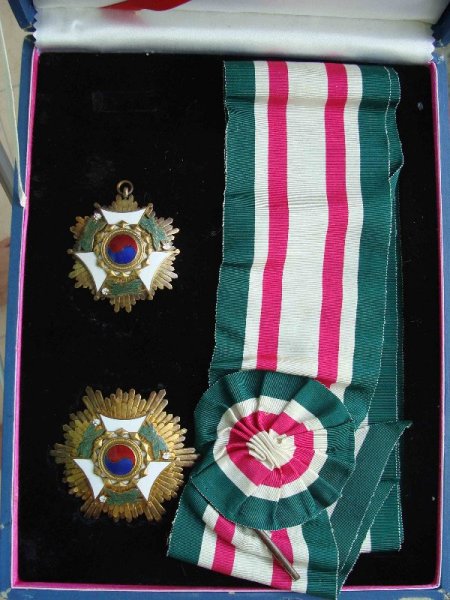
수교훈장 (樹交勳章)
1st Class, 1962 Series with Case.
Total number issued: 8
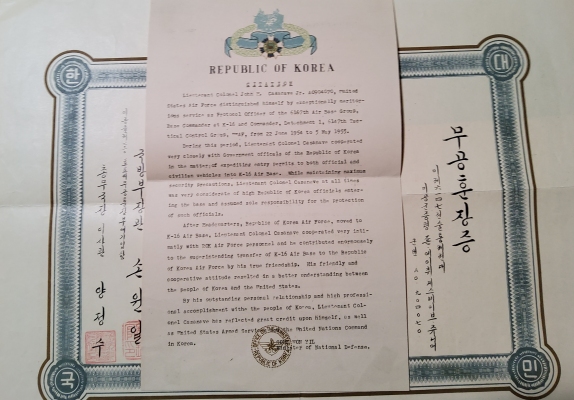
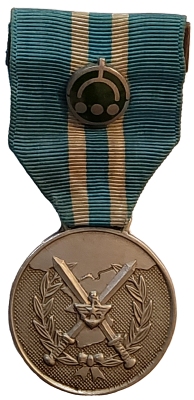
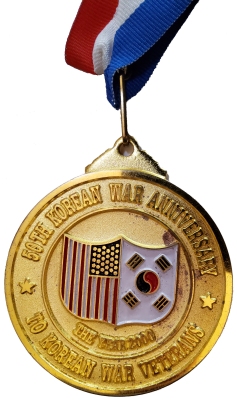
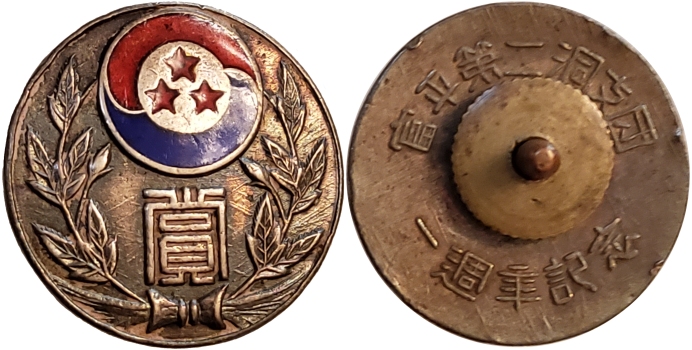
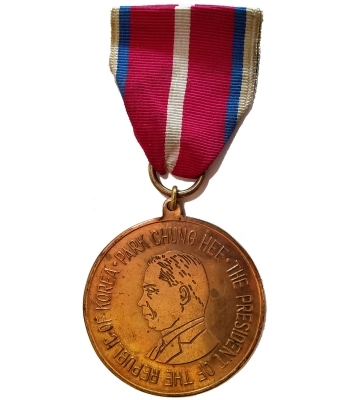
This is the same ribbon as used on the Order of the White Star, 1952 Series, Red Stripes Class Medal which can be found in the second tray.
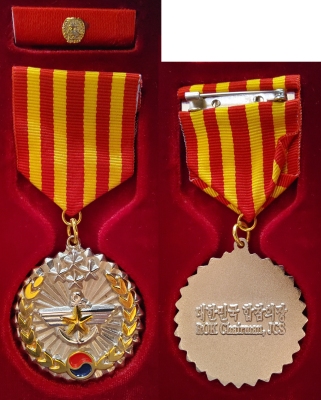
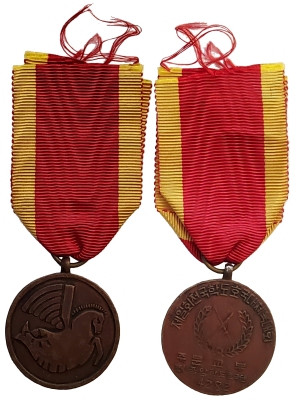
The First Nationwide Student Defense University sports Competition
제일회 전국 학도호국대 체육대회
Order training주문 교무
The Central Student Defense Corps
최중앙학도호국단
4282 (1949)
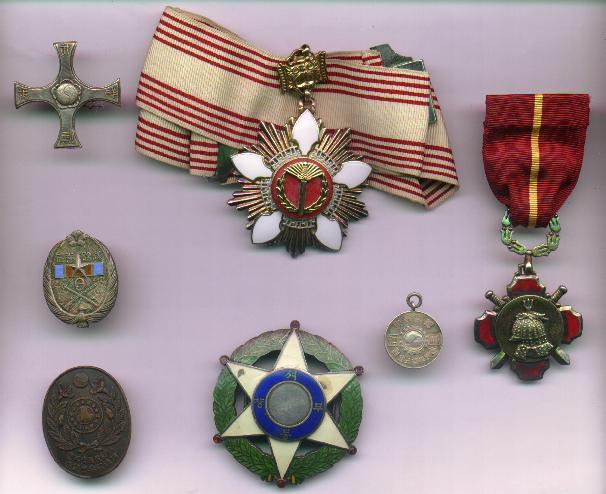
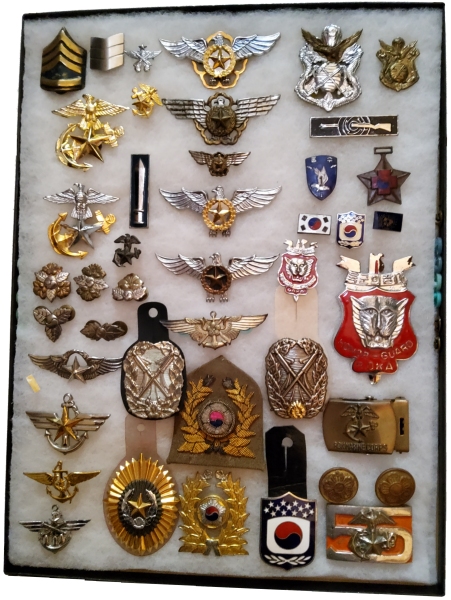
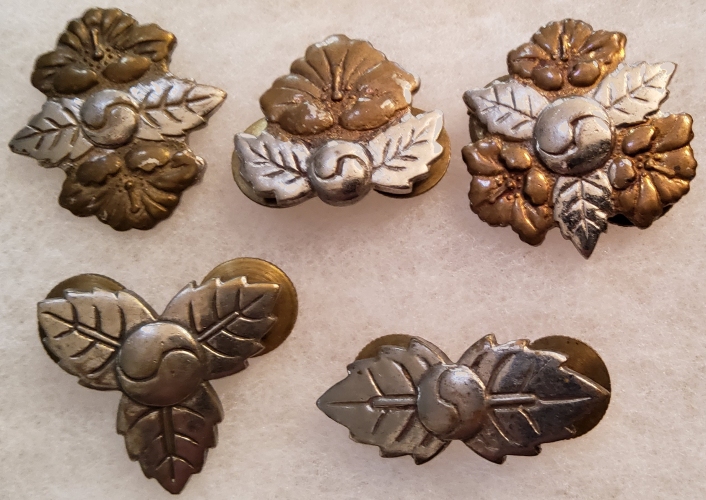
This is their initial rank insignia, established in October 1949. Starting in the upper left: Lt. Colonel, Major, Colonel, Captain, First Lieutenant. Part of the tray to the left.
Note: Between the Korean War insignia of the Korean Army, Navy, Marines and Air Force, the hardest to find is the insignia of the Korean Air Force. It was only used for 5 years (1949-1954). In addition, at the beginning of the War, ROKAF only had 1,800 members and 22 aircraft (L-4/5, T6). In the early days of the war, Korean Air Force personnel physically dropped bombs by hand out of the cockpit. At the end of the Korean War, the ROK Air Force was larger with around 110 aircraft including 79 fighter-bombers and around 10 to 12,000 members.
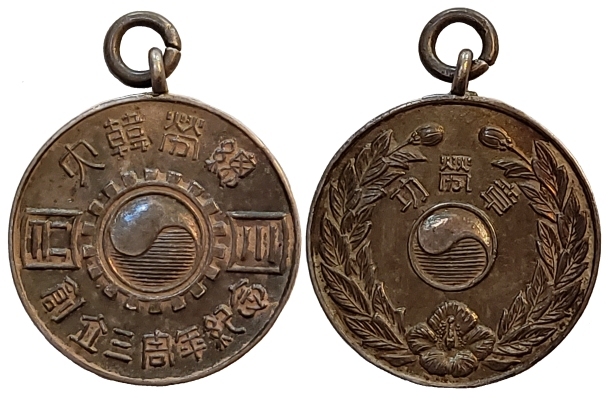
Obverse: (top rocker) Korean Federation of Labor 大韓勞總 (대한로총)
(bottom rocker) Third Anniversary of Founding 創立三周年紀念 (창립삼주년기념)
(banner across center) Inchon 仁川 (인천)
(center) Logo of the Korean Federation of Labor
Reverse: Merit Medal 功勞章 (공로장)
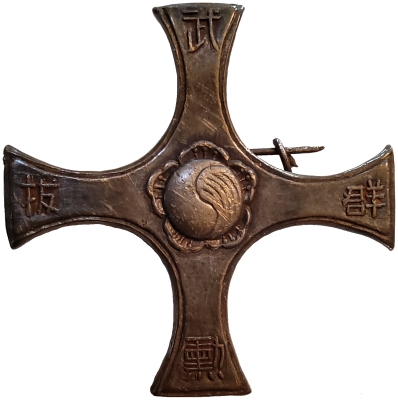
武勳拔群章 (무훈발군장)
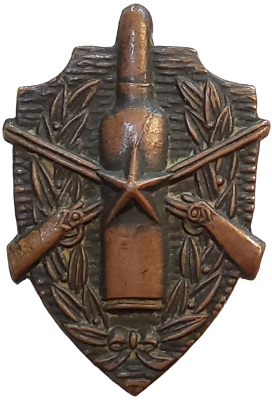
Korean War Period – Hand stamped number on reverse. 4
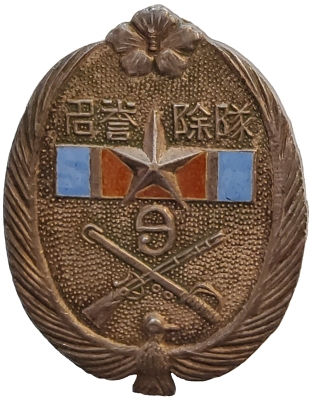
隊除誉召 (대제예소)
The red and blue ribbon bar behind the star is for the Standard Wound Medal
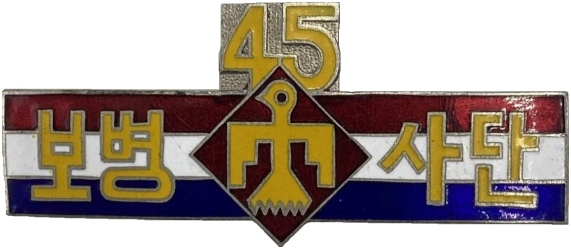
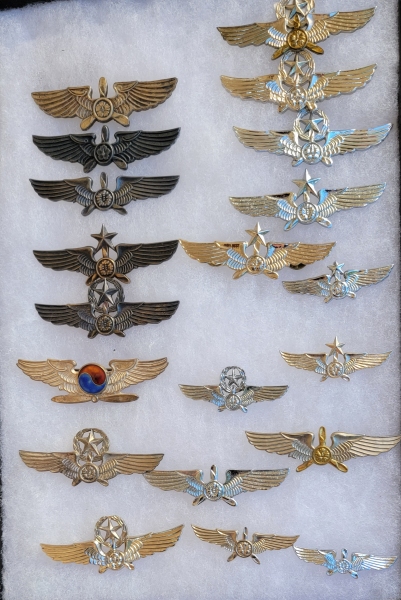
The darker ones on the left are probably silver and date from the Korean War period. The one just below the four is a very early set of Pilot Wings but I have been unsuccessful in dating it.
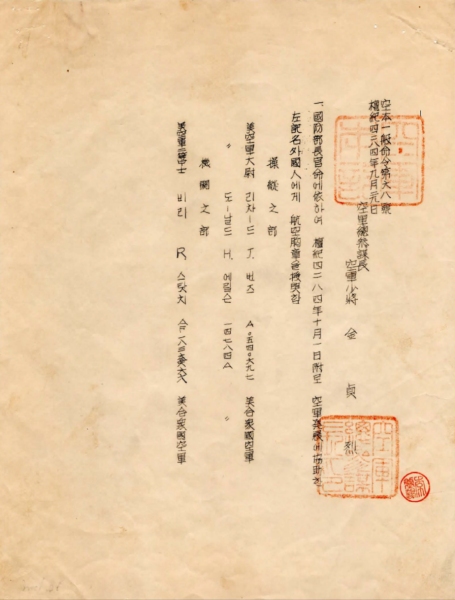
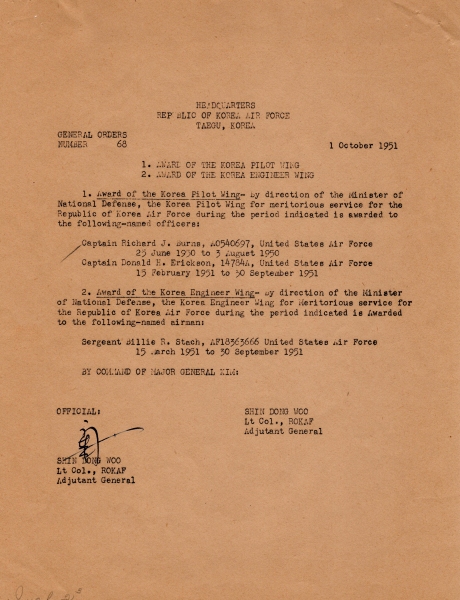
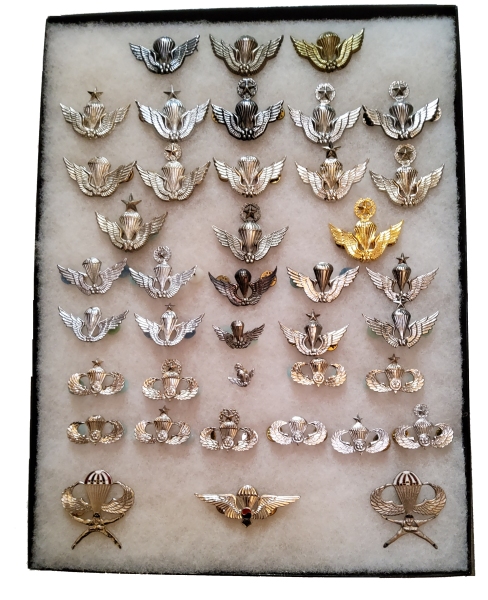
Korean War – Military Forces
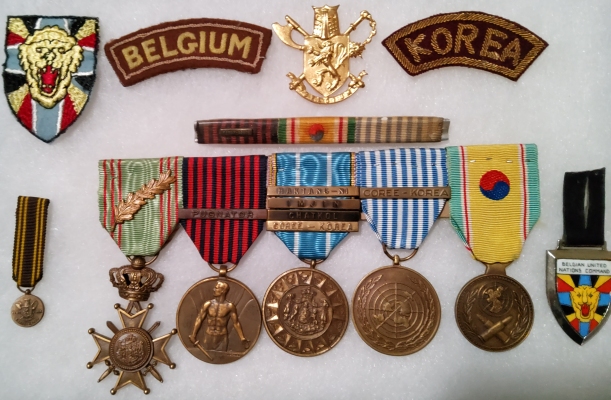
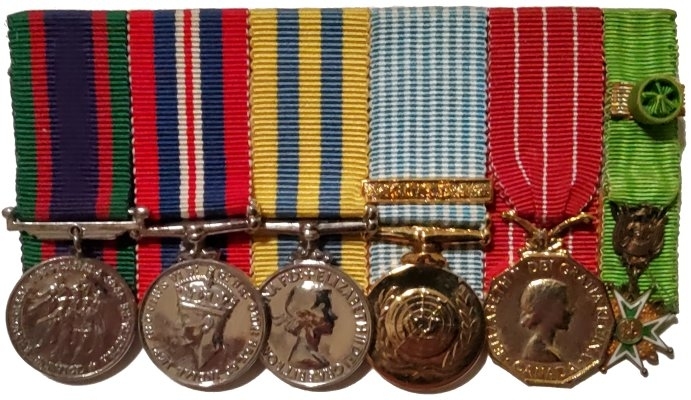
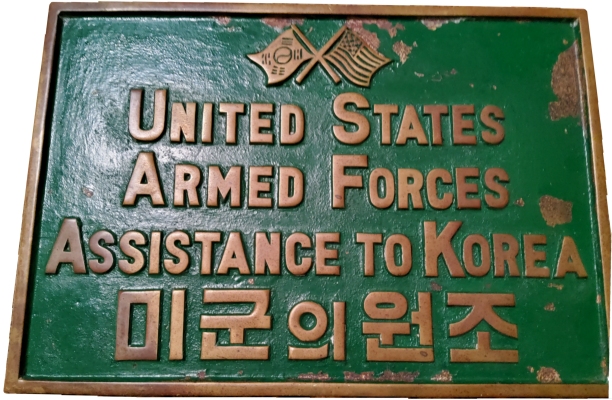
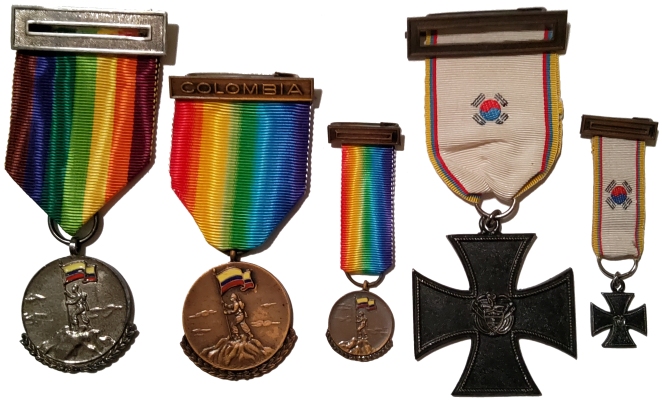
The first medal on the left is a reproduction.
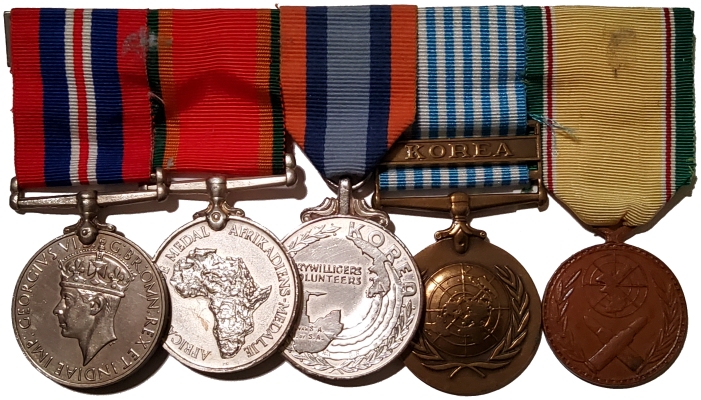
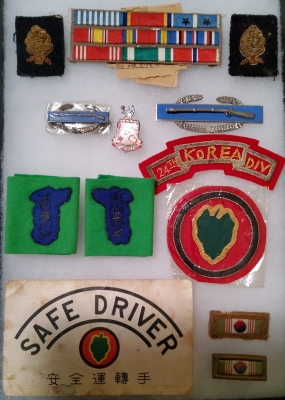
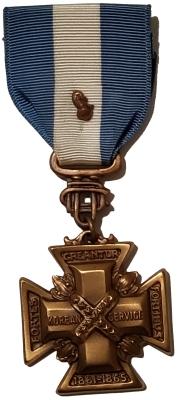
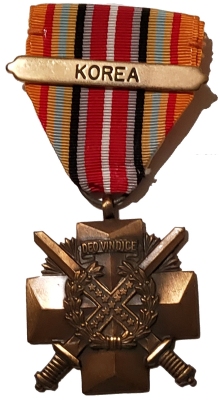
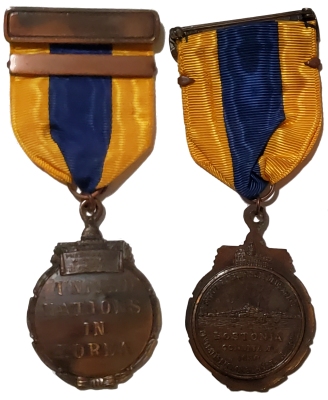
Korean Service Medal
G.I. Souvenirs
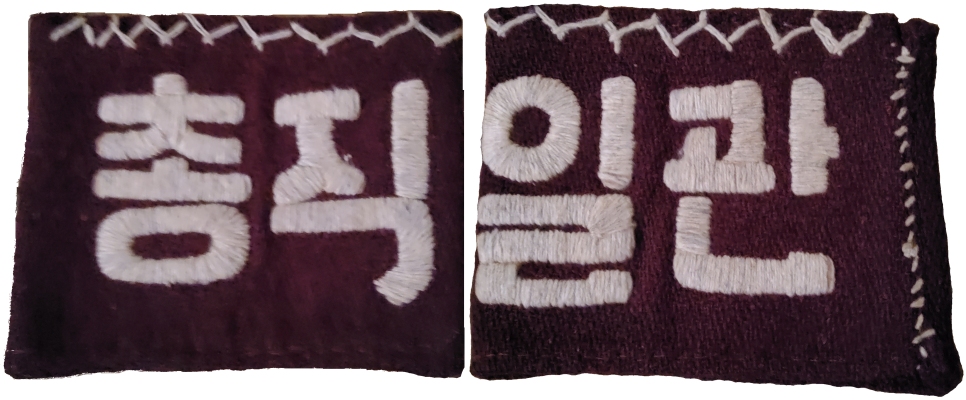
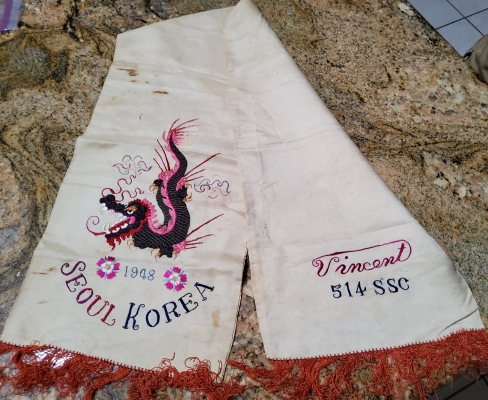
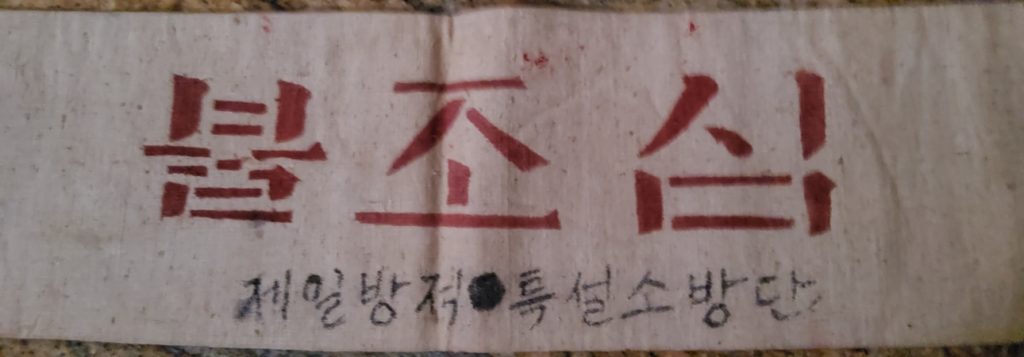
제일방적특설소방단 First Special Fire Fighting Team

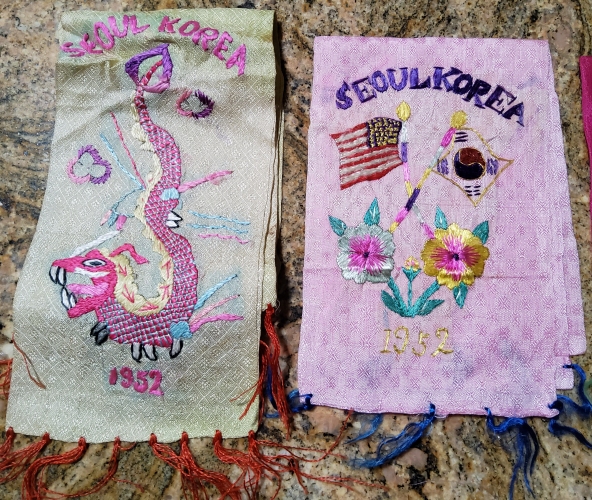
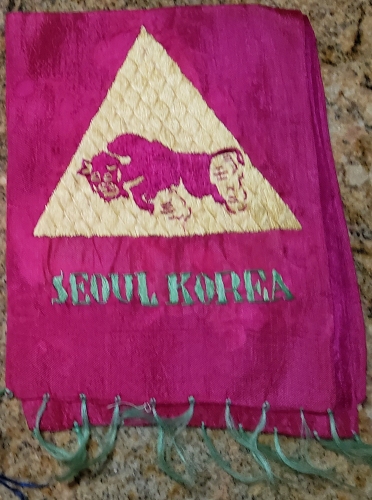
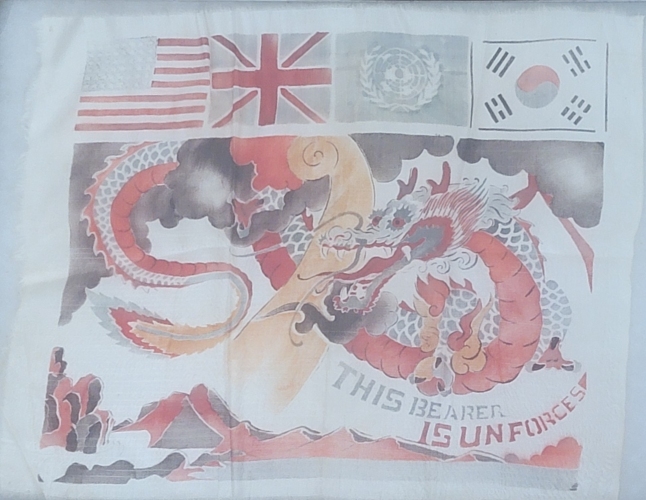
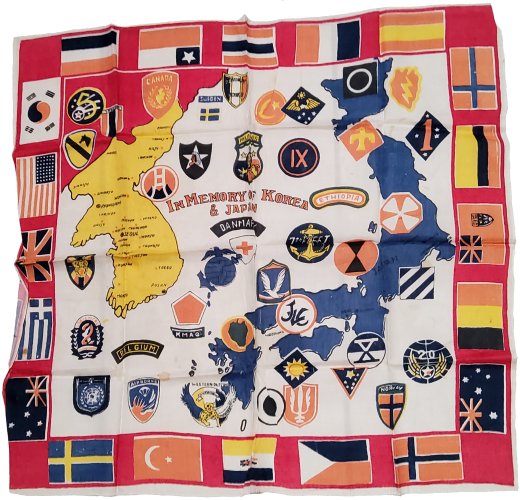
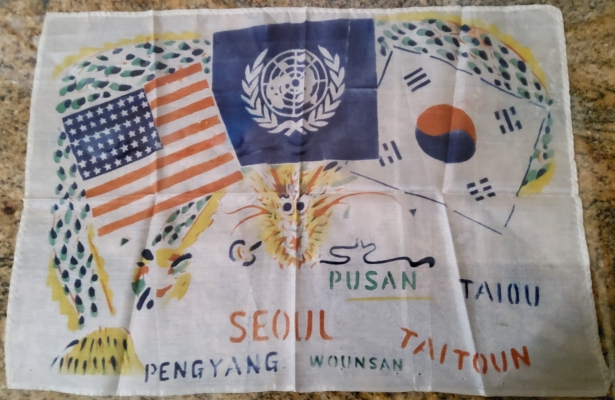

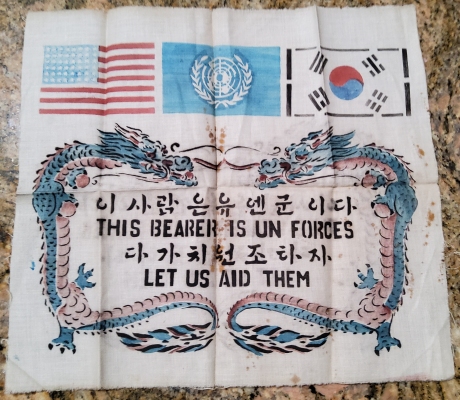
These are UN forces and 다가치원조하자 Let’s help each other.
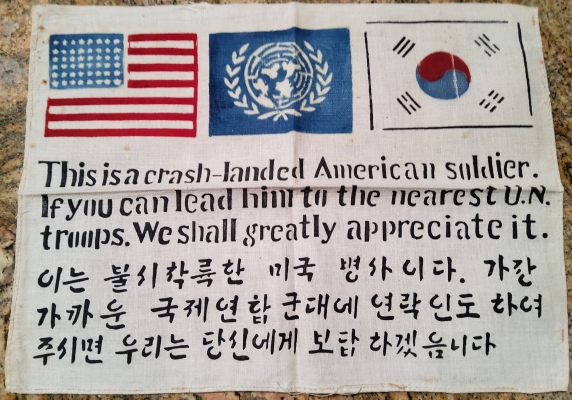
The English text is not an accurate translation of the Korean
이는 불시착륙한 미국 병사이다. 가장 가까운 국제연합군대에 연락인도하여 주시면 우리는 당신에게보답 하겠음니다
This is an American soldier who made an emergency landing. Please contact the nearest United Nations military base and we will repay you.
At this time in Korean history, they generally did not use a lot of punctuation.
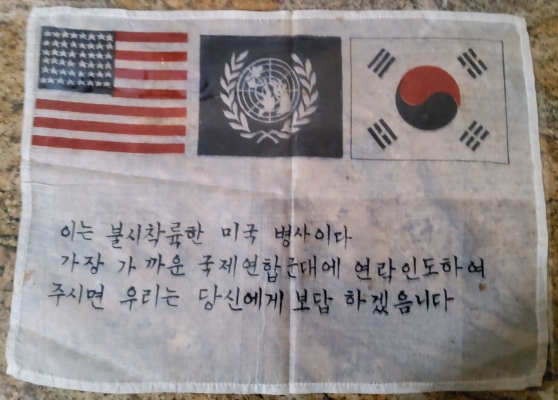
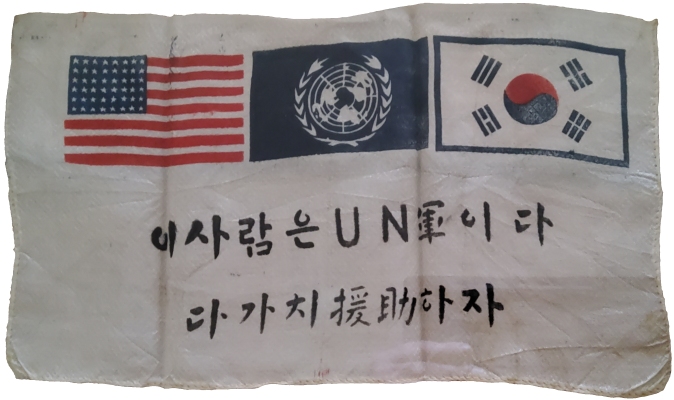
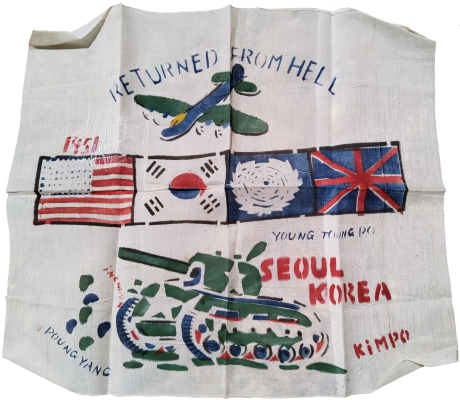
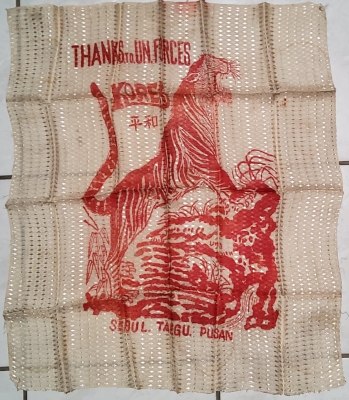
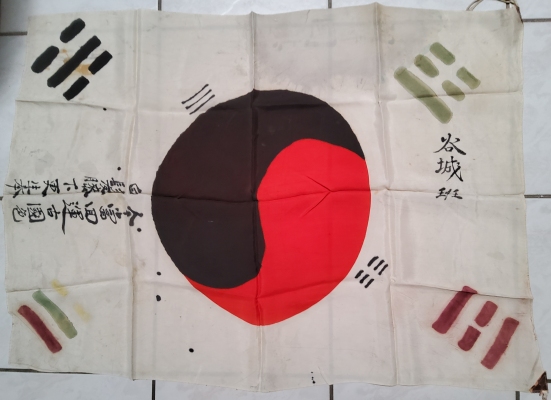
Concerning the flag at the left.
The three Chinese characters, on the right-hand side, are 谷城班 (곡성반). The first two characters are Gokseong 谷城 (곡성). A straight forward translation is “Valley Castle”. (In Japanese it is the surname for three different families: Tanishiro, Tanijou and Yashiro.) Gokseong is a geographical location in South Jeolla Province 전라남도 (全羅南道), South Korea. The province is also known as Jeonnam 전남. There is both a Gokseong County 곡성군 and Gokseong town 곡성읍. Gokseong is very near Jiri Mountain 지리산 (Jirisan). The third Chinese character is 班 (읍) can mean group; party; class, but in this case, it probably translates as “(military) squad”. So, the entire phrase 谷城班 (곡성반) translates as Gokseong (military) squad. The characters on the left-hand side of the flag is a poetic expression written in Traditional Chinese: “We should return the country back to the old glory days. May you be blessed with many descendants to care for you in your old age.” I am unable to elaborate on this expression.
Some background information:
In a six-month period from July to December 1949, the Korean army mounted 542 separate counter-guerrilla actions, nearly three operations per day. On Apr. 15, 1949, the National Korean Police Bureau established a Special Police Force specifically for the Jiri Mountains. After the Inchon landing, thousands of North Korean troops turned to guerrilla actions, especially in the area around Jiri San. In November 1950, the UN Command reported; “The scope and effectiveness of guerrilla activities kept approximately 30 percent of the total UN troop strength in Korea engaged in anti-guerrilla operations, diverting combat units from front-line duty and precluding formation of adequate reserve.”5 The following month, Police Combat Commands were established in the Taebaik and Jiri Mountain Areas. Another Police Combat Command was established in April 1953 for the Southwest Area of Korea. The Southwestern Combat command was disbanded in June 1955, almost two full years after the end of the Korean War. It wasn’t until May 9, 1957, that the Korean government was finally able to clear the Jiri Mountain area.6 The “Anti-Guerrilla Warfare Service Medal” was created in 1951, for the troops who fought to clear Communist insurgents.7
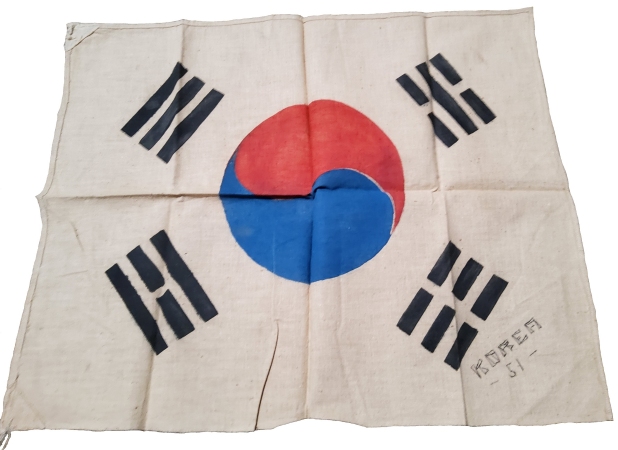
Dated 1951
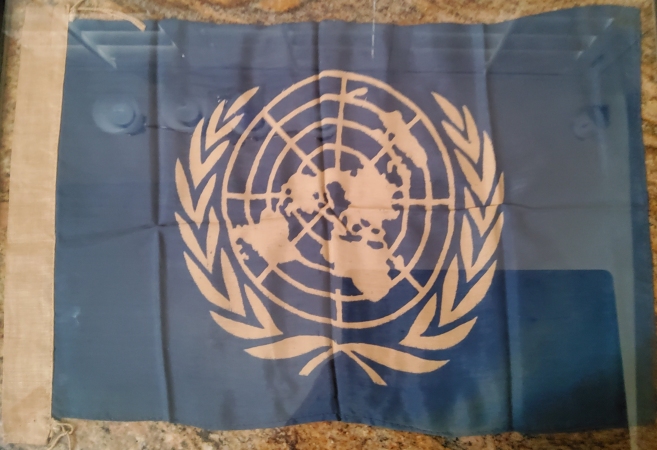
Had to place under glass to keep flat – hence the reflection
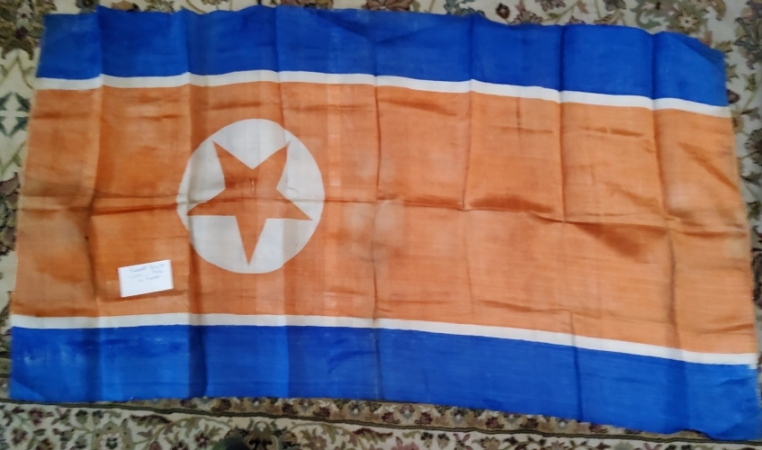
Purportedly because the star is off-center, this is an army flag or battle flag, but, this is the standard flag of the Democratic Peoples Republic of Korea
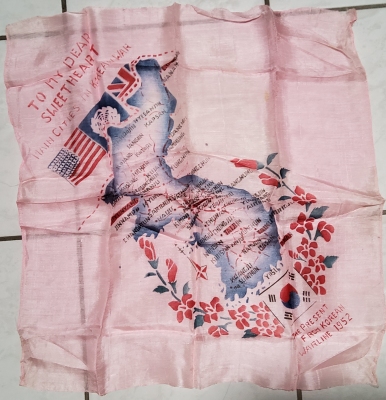
(You can see the floor tiles through the scarf.)
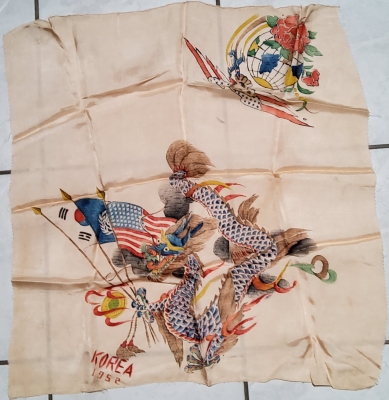
Dated 1952
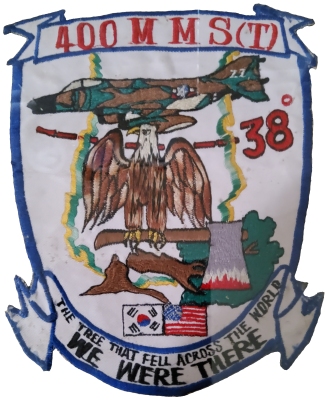
The hatchet and tree symbolize the Panmunjom Axe Murder Incident 판문점 도끼살인사건 (板門店도끼殺人事件, 도끼蠻行事件). Two US Army officers, Captain Arthur Bonifas and First Lieutenant Mark Barrett, were killed by North Korean soldiers on August 18, 1976, in the Joint Security Area (JSA) of the Korean Demilitarized Zone (DMZ). They had been part of a work party trimming a tree in the JSA. One of the South Korean reserve personnel involved was Moon Jae-in, who would later become the President of South Korea. On April 27, 2018, Moon would personally meet the North Korean Leader Kim Jong-un at the JSA, less than 1200 feet (0.37 km) from where the Axe Murders took place. For an in-depth description of the event, see: “Axe Murder Incident”. In the entire history of North/South relations, this is the only incident for which the North Koreans apologized for their actions.
Patches
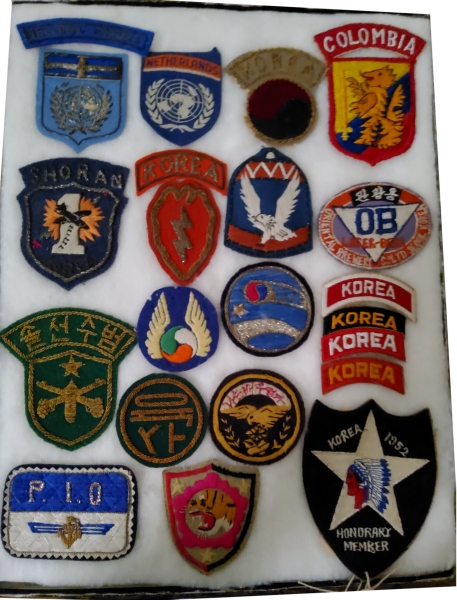
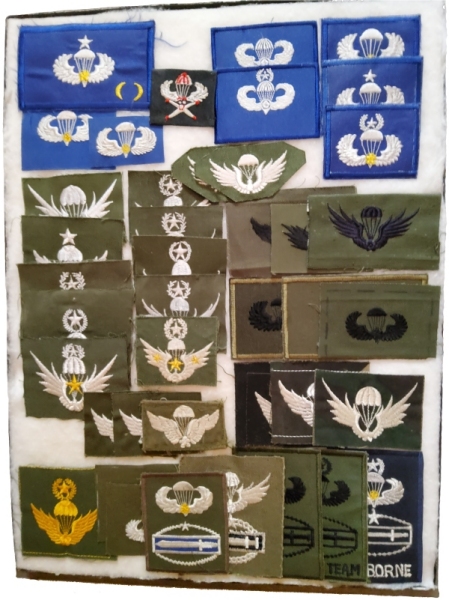
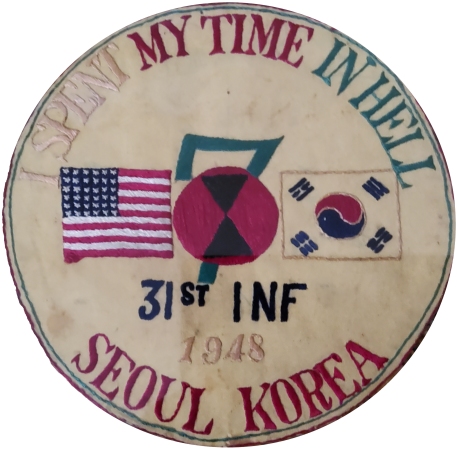
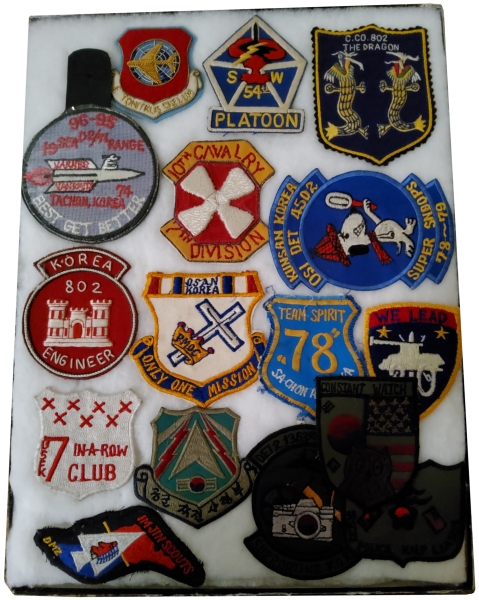
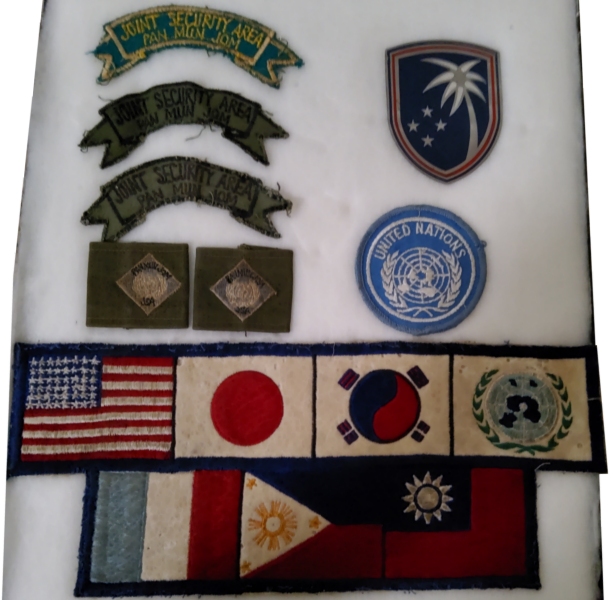
You may be wondering about the patch in the upper right corner. True, there are not many palm trees in Korea, but this is the ROK Army 100th Logistics Command Patch from the Vietnam War.
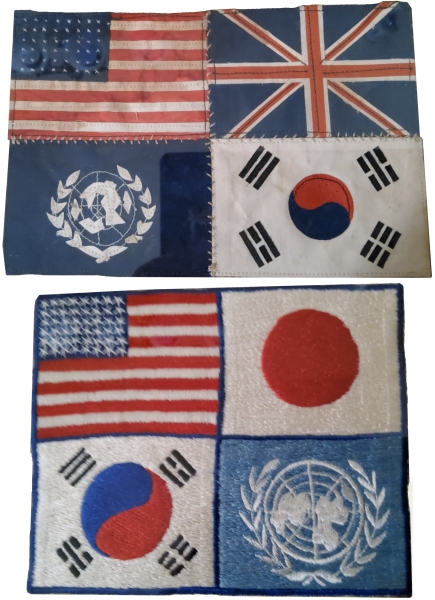
Major General Archer Lynn Lerch
Major General Archer Lynn Lerch (아처 린 레흐 소장 Jan. 12, 1894–Sept. 11, 1947) had a long, distinguished career in the army. He served as a Calvary officer with the American Expeditionary Forces in France during WWI and continued to serve through WWII. In 1938 he became a Provost Marshal and served stateside throughout WWII. After the war he participated in Eighth Armies, Operation Blacklist Forty, which was the code name for the United States occupation of Korea between 1945 and 1948. It is more commonly known as the U. S. Army Military Government in Korea (USAMGIK). On Jan. 4, 1946, he became the American Military Governor of Korea. As the Governor General, he proposed the creation of a Korean Transitional Legislative Assembly 남조선과도입법 to Lieutenant General J. R. Hodge, commander of the United States Army Forces in Korea (USAFIK). After obtaining his consent, he announced the creation of the South Korean Interim Legislative Assembly through Military Government Ordinance No. 118 on August 24, 1946.8 On August 29th, 1947, Major General Lerch suffered a massive heart attack, and died as a result on September 11th. He is interred at Golden Gate National (Veterans) Cemetery in San Bruno, California.
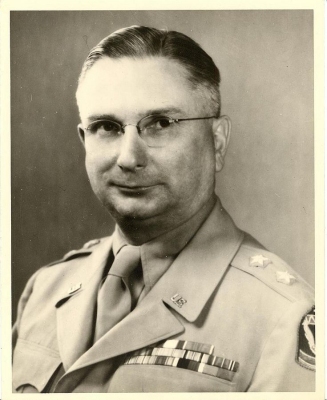
This picture is not in the collection.
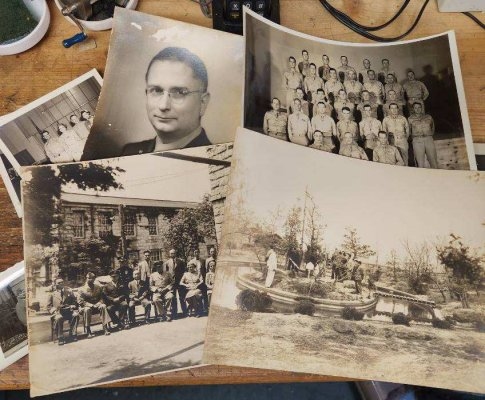
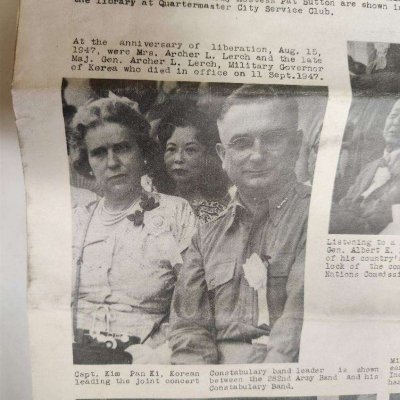
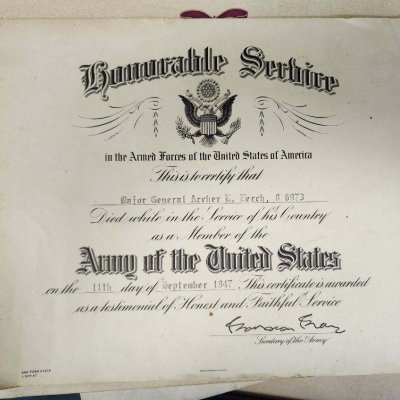
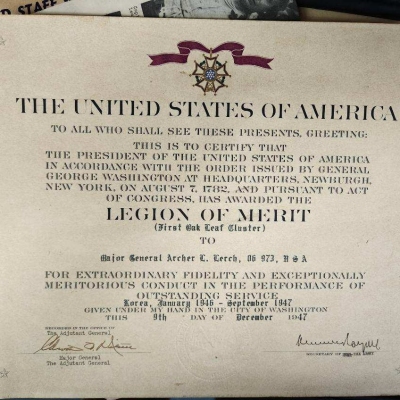
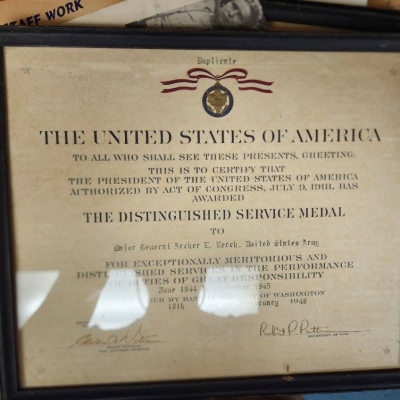
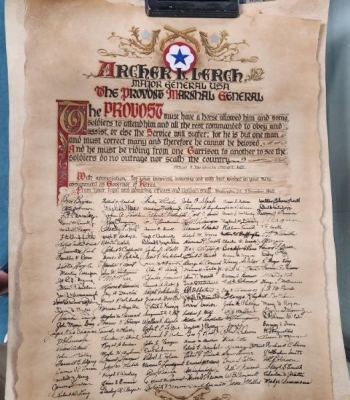
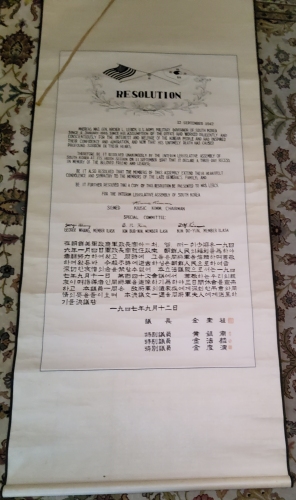
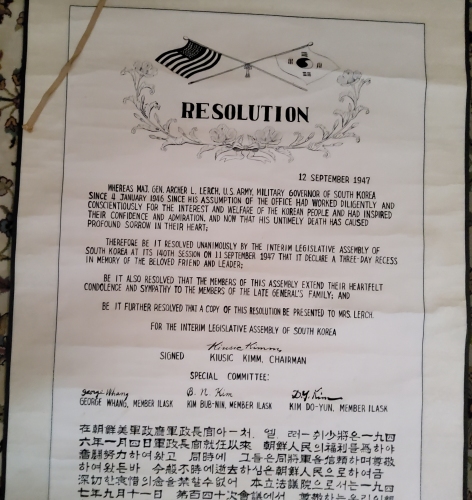
North Korea
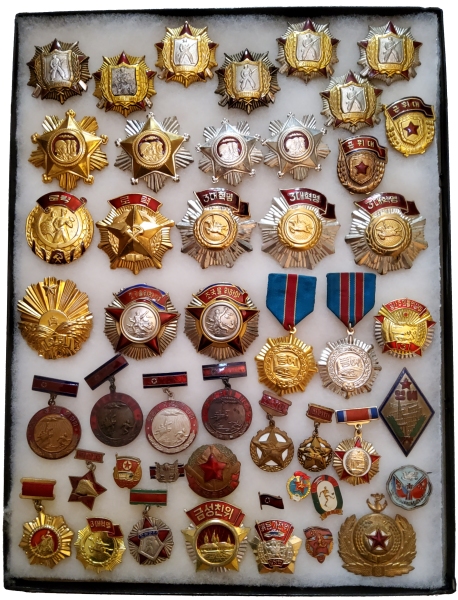
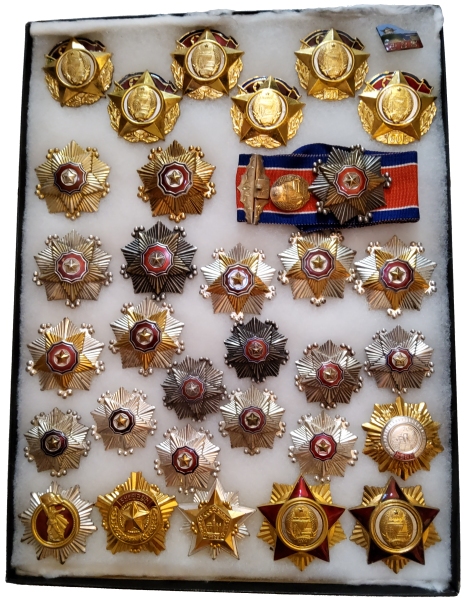
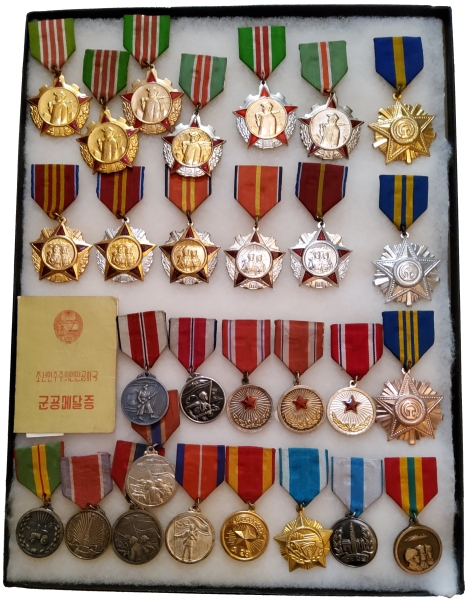
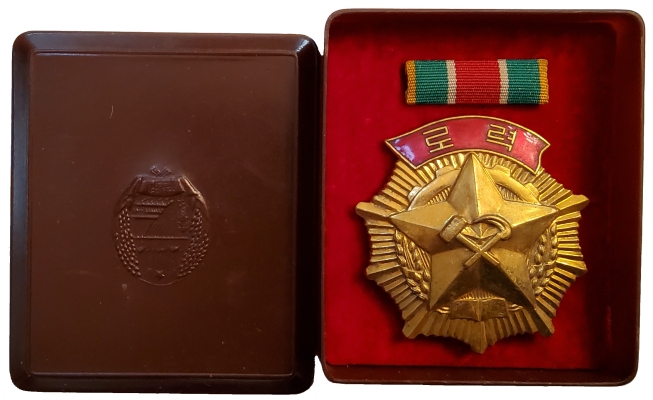
Current Issue – Cased
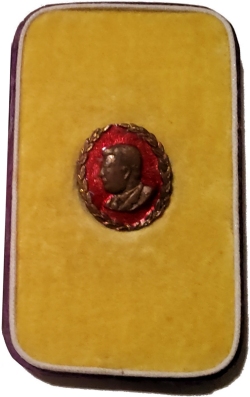
This badge was manufactured for the Association of Korean Residents in Japan, Chōsen Chongryon 조선총련 (朝鮮総連), which is a pro-North Korean organization. See my webpage on “Koreans in Japan Today”.
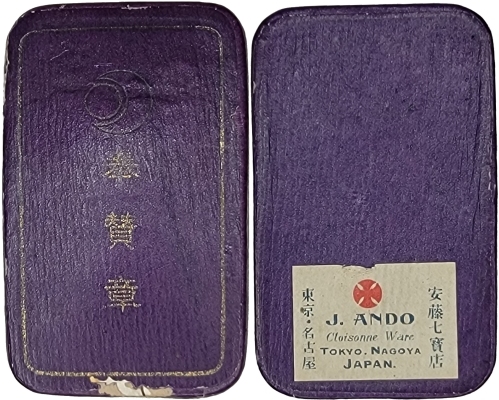
This was manufactured by the Ando Workshop out of Nagoya and Tokyo, Japan.
For more extensive information on North Korean Orders and Medals, see:
- Military and Civil Awards of the Democratic People’s Republic of Korea (DPRK), by Warren E. Sessler and Paul D. McDaniel jr. (This is the definitive work on the subject.)
- Orders and Medals of the Democratic People’s Republic of Korea, by David Cabral (This was an early pioneering work on the subject.)
- Orders, Decorations, and Medals of the Democratic People’s Republic of Korea, by Col. William A. Boik, USAR (Ret.)
- Research on the National Honor System of the Democratic People’s Republic of Korea 朝鲜民主主义人民共和国国家荣誉体系研究
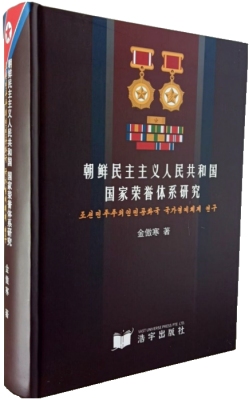
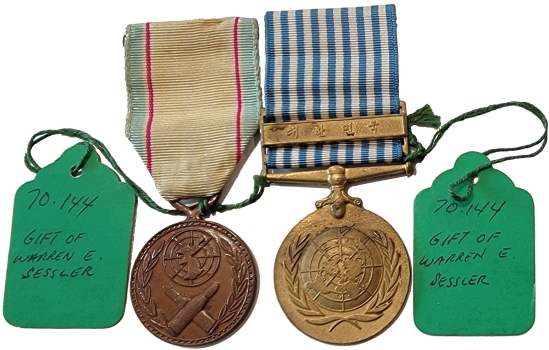
Not part of the George Notarpole collection.
China
Generally speaking, any Chinese Medal that is not enameled is a reproduction. The Chinese government has done nothing to maintain the dignity of their medals.
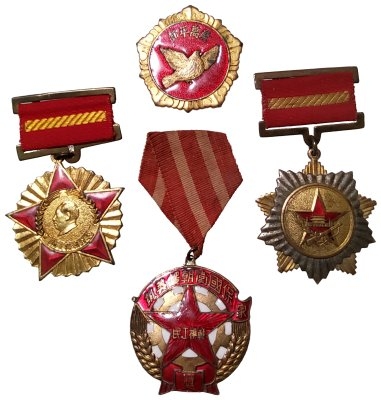
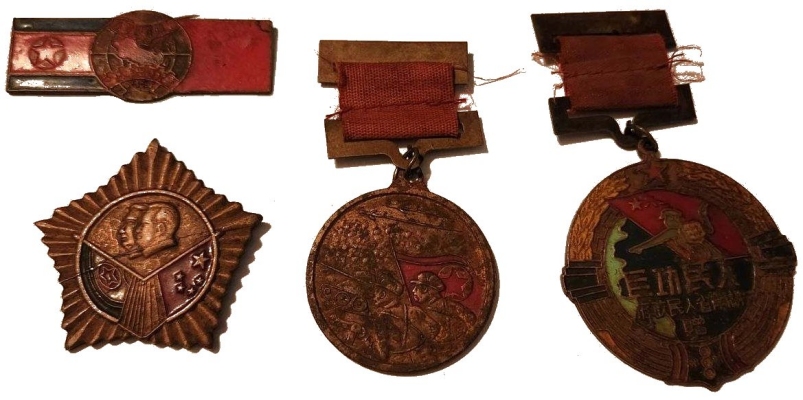
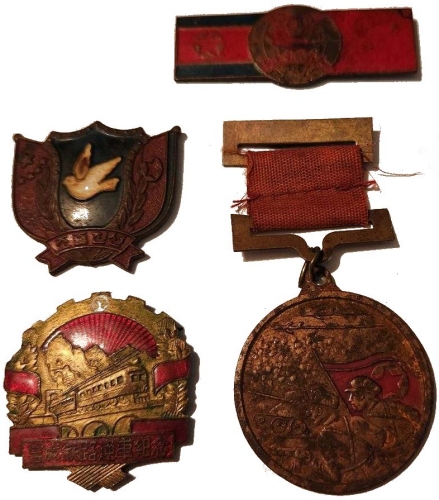
Footnotes:
- The OSS began training Koreans in May 1945 in Xi’an, Shaanxi Province and Fuyang, Anhui Province. The news of Japan’s surrender was heard the day before the first Koreans were due to be deployed in Korea as guerilla forces.
- The Korean town 군산시 can be romanized as both Gunsan and Kunsan. The United States Air Force uses Gunsan to refer to the town, and Kunsan to refer to the air base. The air base is named after Gunsan City, a port town seven and a half miles east of the installation.
- Often, departing Japanese servicemen would leave behind clipped fingernails and hair, so their relatives would have something of him by which they could hold a funeral.
- See Republic of Korea Army, Vol 1, 1954, end cover or Republic of Korea Army, Vol. 2, 1956, end cover
- Command Report, General Headquarters, Far East Command, UN Command, Nov. 1950, p.25
- Korean Report, Volume V, Reports from the Cabinet Ministries of the Republic of Korea for 1957, p. 37
- Presidential Decree #488
- The South Korean Interim Legislative Assembly was dissolved by the Interim Government Act No. 12 on May 20, 1948.
